Kult by PurpleXVI
Introduction
Original SA post
Alright, since it seems like there's a bit of interest, let's do this! It's time for...
Kult!
"Death is only the beginning."
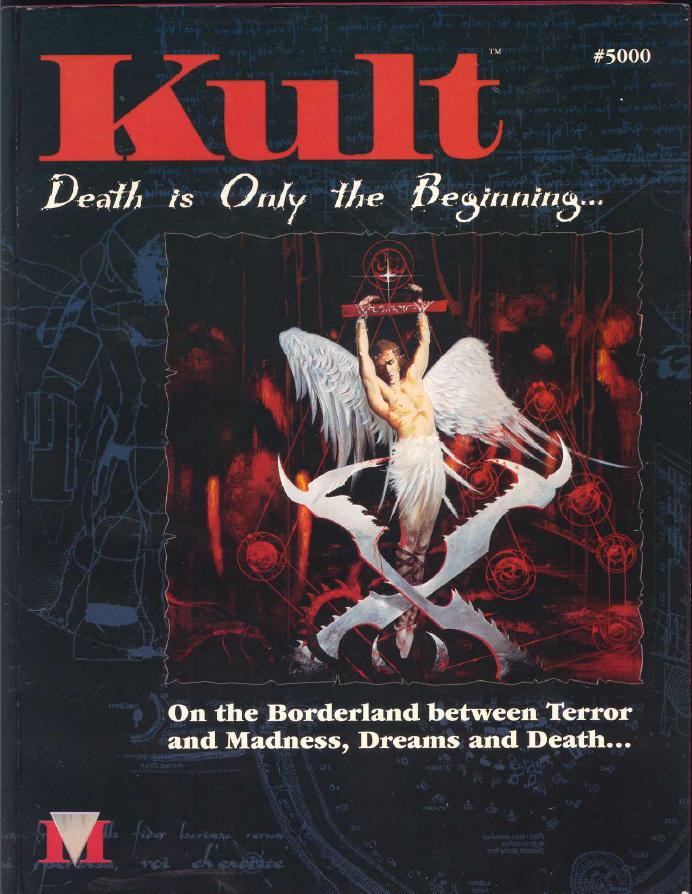
(Any and all images will be from an old .PDF copy of the core book, since I'm not going to screw around with scanners and the like, so apologies for any poor image quality.)
That, up there, is the front page. Immediately after is a splash page with a big red THE LIE on it, little else, and then first contact with Kult's internal art, which can be... interesting.
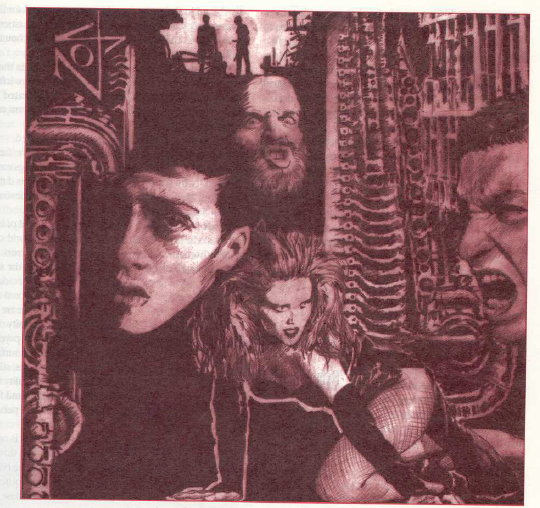
We've got some Geiger-esque architecture, some grimacing faces and a prostitute who(judging by her hair) is from the 80's. And we haven't even dealt with any of the writing yet.
The Lie
The Lie is where we get introduced to the setting. It starts out painting a pretty grim image, basically telling us that the world is a cold and nasty place where there's bad shit lurking in all the shadows, and bad dudes hanging out in all the buildings, and they're generally doing Bad Things.
quote:
"We live in a world where the sun has set. Forlorn creatures roam deserted streets in crumbling cities, in search of terrors from their own past. The demons of the cities were spawned by the forgotten grief of these vague existences. Now they prowl the realities, striving to shackle their old masters: humankind."
It may be slowly becoming obvious that Kult is not a bright and cheerful game, it's usually rated as one of the things that make a session of CoC seem uplifting.
Past this flavor-text, though, the game starts telling us what's REALLY going on, alongside a "Sisters of Mercy" quote, it informs us that the world is full of supernatural and weird shit and that, honestly? It doesn't matter. Because all this stuff is just an illusion. God himself is missing, possibly dead. The Antichrist(or some equivalent, it's just one of his names) is walking free. Heaven and Hell are just things we inflict on ourselves with our own minds when we die. More and more people are slipping through the cracks in reality, intentionally or not, seeing what lies beyond our mortal, everyday illusion.
People are so perverted and maddened by modern life that our very dreams are sick enough to let demons and worse crawl into our side of the veil.
quote:
"Such is the world in which the heroes of our game must live. Are they helpless leaves blown around by the cosmic winds? No. They are vehicles of destiny, bound to act in myths they have never heard of. Myths which people have forgotten, but which are reborn in the thronging cities where no truth is greater than another."
This is where the game starts telling us what PC's in Kult should be. Not pure crusaders, not helpless lambs but instead, as it puts it: "We should think of them as lost souls who need to kill their own demons in order to have peace."
The PC's may be stuck in some vast, incomprehensible, chaotic and rotten world, but ultimately, we're told, what they're doing should be tied deeply into their own motivations. Because Kult's world is one where human minds and motivations can have deep and unsettling effects on things around them.
quote:
"This game can be played very darkly..."
REALLY, KULT? REALLY?
quote:
"...but that is not the point. Rather, we like to think that the heroes should seek out the darkness and accomplish something by fighting it. In a way, it's their own fears they struggle against; when they win they gain some wisdom and a few more scars on their souls."
So unlike games like Call of Cthulhu, we're actually supposed to be making a difference. Not a bad start, really. A black and depressing world where you can, if not make a difference to the whole thing, at least make a difference for your character.
Afterwards we're straight out told(again) that God, the Devil, Angels and Demons, really do exist, that humans can do terrible evil, but also incredible good.
Instantly followed by a darkened text box about how this is just A GAME, not necessarily the personal beliefs of the writers about the world in general. This may be because as D&D was blamed for BAD EVILS in other parts of the world, Kult caught some flak in Sweden and was accused of getting some people killed or missing.
They also quickly get a head of a lot of bad games by telling us what we can do with it in a more concrete sense, namely: Recreating horror stuff like Nightmare on Elm Street, or psychological thrillers, or action, the PC's can be good folks or evil sociopaths. We're essentially being given some ideas, but ultimately carte blanche to just go and have fun.
THEN after getting us interested, they segue into telling us what roleplaying games are.
Nothing really new here, it's the thing that's at the start of almost every RPG. We're told that having fun is the utmost objective and that everyone should just play it Their Way instead of thinking there's some perfect way to do it.
To avoid boring those of us who already know what this is like, they add some more of Kult's characteristic and uplifting art.
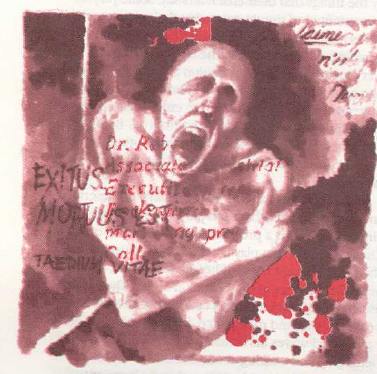
Then comes the first the first Example Of Play !
Cassandra and Peter, two Player Characters, are rolling up to a deserted harbor warehouse at night, hoping to find their kidnapped third Player Character, Gilbert. However, it turns out they've walked into, well...
quote:
"In the middle of the room, with his arms backwards over a steel bar, hangs Gilbert. Large chains hold him to one of the bars that hold up the roof. He is naked and splattered with what looks like black oil. A crisscross pattern of thin lacerations covers his body. Blood is dripping from the cuts, down to the floor which seems to absorb every drop. A dull red light appears to come from the concrete around his feet."
Oh, shit, that's unsettling! N-
quote:
"In a semi-circle around him stand the men from the club. They are all dressed in tight black leather pants and their upper bodies are bare. Long, thin knives glint in their hands. They haven't seen you. They continue to slowly cult more long, thin lines in Gilbert's shivering body."
Oh. Oh .
So yeah, Kult has, predictably, cults, and some of this cult business involves sex, pain and blood. We'll get into that in a later chapter, but suffice to say: It's handled more maturely than Cthulhutech or FATAL would have.
Back in the Example Of Play, our players act like actual players and, despite their buddy begging them to kill him, decide to open fire on the creepy goons. The reason he's begging the other players to kill him is that his character is already doomed to die, and he's roleplaying this.
By not killing him, the other players have turned his body into a vessel for a demon which effortlessly tears down the beams that he's chained to and starts walking towards them menacingly.
Now, we don't know what's come before here, whether the GM worked out a cool plot with Gilbert, or just slapped him with a save-or-die demon possession curse. Either way, Kult seems to be setting us up for some very story-based play where it's more about playing a role than making sure your character survives to the finish line. I'm giving them the benefit of the doubt so far. This may change once we get into the mechanics which, surprise, are coming up next!
Or at least, the very basic-most mechanics, which we are helpfully explained near the end of the first chapter, just enough that we can judge whether they're retarded or not:
Roll a D20, if it's under your intended target number(usually a skill or ability), you succeed. The higher you roll while still succeeding, the better.
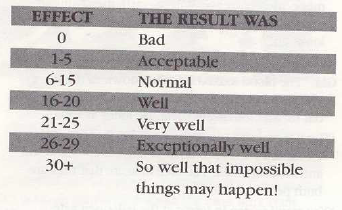
Simple and easy. Huh.
We're still in The Lie, but this is the introductory sub-chapter which tries to get us into the game and, honestly, does it pretty well. We're told about the world in broad terms, we're told about what sort of characters we should think of playing, what sort of adventures we should consider having, we're given an example, and we're told what sort of basic mechanic we're judging things by from here on out.
Next time(assuming you guys don't lynch me for being unfunny or a bad writer), character creation!

I know this image just gets me all sorts of excited for that! Dibbs on playing Dark Skullstick or Shades Three-Gun!
Apologies if it seems like I'm not being very detailed so far, but the game starts us off with very broad details, so if there's anything you feel like you want to know more about, that's almost certainly explained later in the book.
Character Creation 1
Original SA post Kult!The Lie: Character Creation!

The chapter starts with this, and though we've just seen it, I feel like it's worth sharing again. It's just goddamn amazing. I don't even know what they were going for, but it's mesmerizing.
Following that a brief piece of fluff, about someone working for The Company who attends a funeral where the corpse starts climbing out of the coffin in the middle of the service, something that some of the other Company men there were apparently expecting. Exciting!
Then it kicks into the sort of stuff we already got from the last chapter, about what sort of characters you can play. It gives some ideas and, ultimately, it all comes down to: "Play something you enjoy, we're not going to ban any concepts, though likely your dudes will not be pure villains or pure heroes, but somewhere in between." You know, sensible stuff.
It follows this up by guiding us through character creation, starting with the entirely fluffy parts and goes maybe, just maybe, a bit over the edge with what it would be vital to know about any given character.
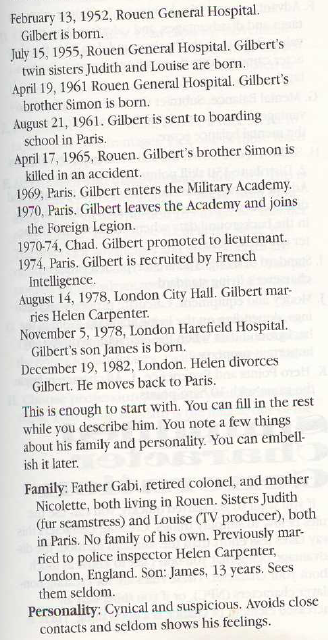
Personally I would consider it important to have more detail about their personality than their extended family and the exact dates of every major moment in their lives. But, hey, this is how Kult rolls. Let's roll WITH it.
It gives some handy advice on how to stick character groups together(either give them a good reason to hang out together or a good reason to all be interested in the same thing), and that's really relatively unremarkable. We're low on crazy for this.
Then we get the line-up for what we need for a character.
Personalia: Superficial stuff(appearance)
Archetype: Presumably there's a list, as we're told we can also create our own.
Background: Duh.
Abilities: For which we have 100 points! And we also need to calculate some SECONDARY ABILITIES. Maybe this will become ridiculous! We will see!
Dark Secrets: If we have a Negative Mental Stability Score we need at least one of these, otherwise they're optional.
Advantages and Disadvantages.
Mental Balance: Apparently our purchases of Advantages and Disadvantages decides how crazy we start out.
Skills.
Standard of living, Money and Equipment.
And we start with ten HERO POINTS.
We're also offered simplified character creation, which involves randomly generating abilities and disadvantages/advantages to speed things up, and instead of flinging around a pool of points, we just assign a few pre-chosen numbers. This seems much easier and I think it might be fun to do this just to see what sort of Kult character it can end us up with, totally not because every other write-up runs through the character creation process and I want to be cool like everyone else.
Before we have a chance to get started making a character, we're distracted by a drive-by piece of art.

As far as I can tell, none of this art is ever really going to be related to what's going on in the damn text. Which is a shame.
SPLASH PAGE, "The Archetypes!" Which handily informs us that the archetypes will be present later on "color pages," and instead tells us what information each of them will contain.
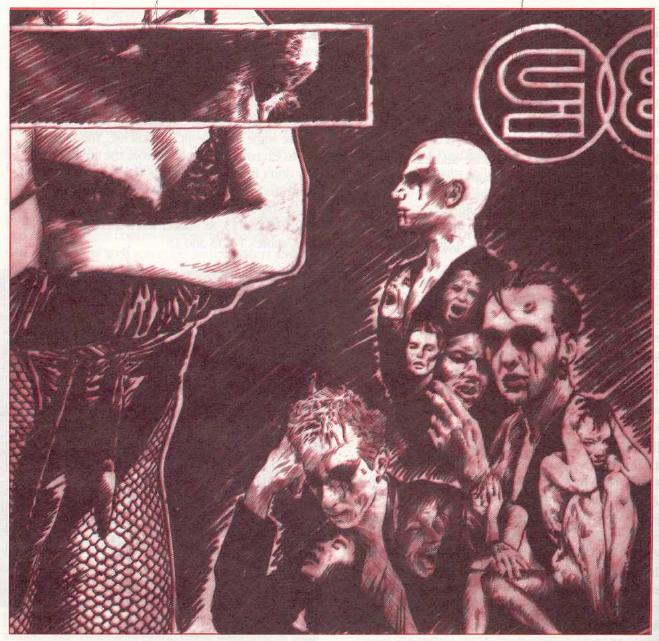
Cleavage and zombies dressed in jackets covered in anguished people are supposed to make sure we don't notice how it's kind of a poor idea to shove one of the first steps of character creation FARTHER back in the book than, you know, the start of the character creation section. This also marks art actually related to stuff that's going down, though, as the following fluff text talks of mutilated "Nepharites" in heavy coats. At least this promises that the inevitable beastiary will be interesting.
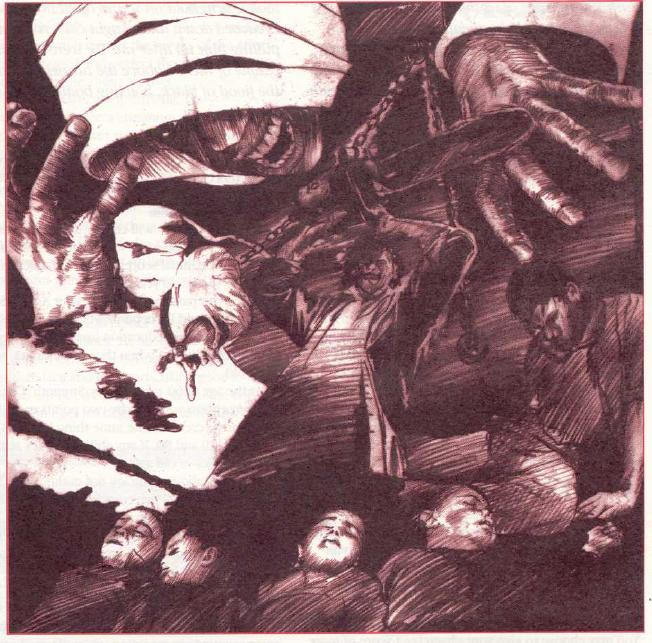
It then jumps us into the Abilities section with this and a small piece of fluff about people being pursued by "wolven" and a "flood of black howling bodies." I'm genuinely trying not to copy every piece of art here, but very little of it is forgettable, most of it's either completely incoherent(like the stuff at the start of the Character Creation chapter), weird like the Cleavage & Zombies or kind of badass in a metal way, like this.
With our introduction to Abilities we get a bit deeper into the rules as well. It tells us that not everything we roll for involves rolling under Abilities like Perception, it can also be Skills like Search. In most games, you'd be rolling under a Skill and a relevant Ability added together, so it remains to be seen if I can be a genius at Searching even if I have a Perception of 1 and am blind as a bat.
Blah blah blah, aging makes us frail, surprise. The earlier success mechanic also becomes a bit more complex as it's now established as only good to roll low, we get those results on the table by subtracting our roll from our ability/skill. But at least this seems consistent so it's kind of hard to fault it. It also explains how we can get those 20+ results.
By the quick character creation, we're rolling 2d10 per stat! So let's see what sort of misfit we end up with.
Agility : 16, we're some sort of acrobat.
Strength : 7, but we can't lift much more than ourselves.
Constitution : 17, always drank our milk.
Comeliness : 5, maybe the explanation is that we're some sort of hideous, rubber-like mutant... because we're ugly as a sack of mutilated pigs.
Ego : 17, this is our "memory, intelligence and willpower" all balled up into one, so holy fuck we're a smart cookie.
Charisma : 8, but obviously we're so full of our superiority that no one can stand us. Note that one of the example uses of charisma is "seduction," predictable, but still doesn't bode too well.
Perception : 19, and our dad must've been half eagle.
Education : 12, this represents how many years we've gone to school, except for every point over 15, which is two years. Presumably this also assumes that we PASSED every year and didn't just spend three years in 8th grade because we were thick as bricks. It also seems perfectly possible to have someone with Ego 2 and Education 20, at least using this method, something that would be hilariously difficult to explain away.
The book DOES note that this method is mostly suggested for NPC's as opposed to PC's, in which case a GM could polish away the worst of the rough edges.
Secondary abilities are a mixture of useless baggage(carrying capacity, movement) that never sees any use, and important stuff(actions per combat round, initiative bonus, damage bonus and how many hits you can take before keeling over).
Now the game's asking us to find a Dark Secret, but we decide that we need to pick some archetypes before we can really get on with that, and page ahead for a bit to find the first colours in the book that aren't black, red or white. And what colours they are.
It's obvious that while these were probably written by the same people, they definitely got a different artist in. For instance, the Gang Member . It is a bit jarring. Just a bit.
Besides him, there's the Avenger, the Dealer( wearing a bright purple suit he looks like he sells women or drugs, but the flavour text suggests machineguns ), La Femme Fatale( Who looks pretty reasonable compared to what some games' idea of what seduction is. ), Private Investigator , Veteran, Secret Agent, Company Caretaker(actual companies, not some sort of sinister The Company this time), Student, Mad Scientist(really, I'm not kidding), City Samurai( This image isn't that ridiculous, but I'm including it so no one can accuse me of making it up ), Muckraker , Plainclothes Cop , Artist , Rock Musician and Outsider.
Gang Member, Veteran and City Samurai are just out because we'd never be able to win a fight with our little girly arms. We don't have the charisma to be a Dealer or PI... so how about we go with Mad Scientist? Our unsettling, maniacal laugh and controversial experiments are why everyone finds us unappealing.
The Archetype page for the Mad Scientist:
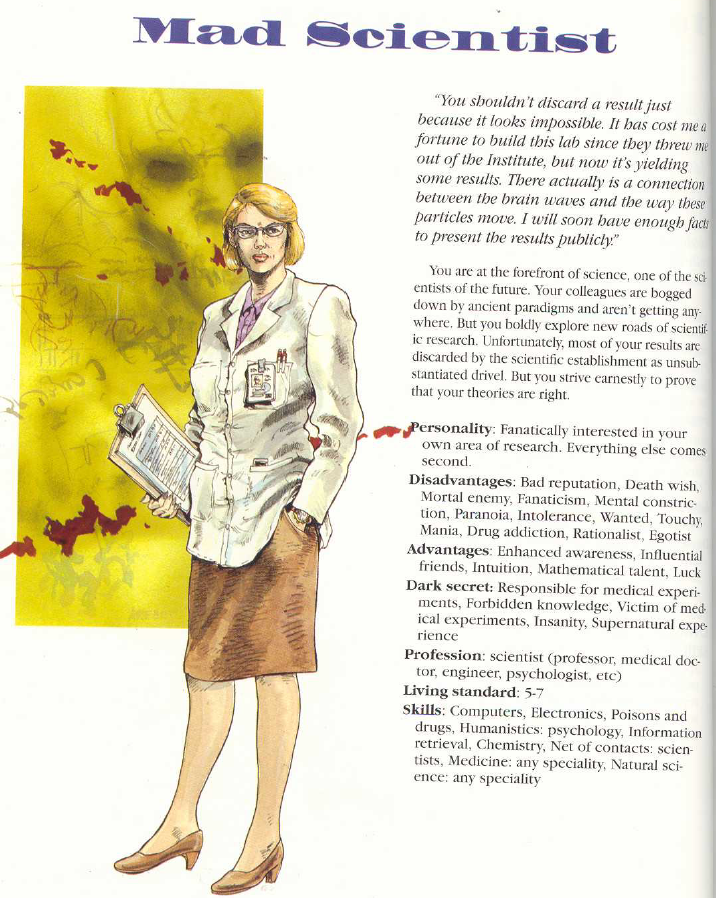
To make things interesting, we'll then need one of the listed Dark Secrets, which should explain any Disadvantages we have(also from the listed, up to five). Apparently we don't need to justify our Advantages this way, lucky for us!
The next chapters are the ones on Dark Secrets and Disadvantages/Advantages, one spoiler for that is that the number of Advantages we have increases our Mental Balance, and Disadvantages lowers it.
So what would seem appropriate for a Mad Scientist? Any suggestions? Ideas for name and background are welcome as well.
Character Creation 2
Original SA post Kult!The Lie: Character Creation(Continued)
So last post we got our way past the, hilarious, archetype art, and decided that for the purpose of character creation we were making a Mad Scientist.
We're ugly as sin and few people like us, but it's alright, because we're also hyper-intelligent, fast, have shitloads of endurance and can see forever. So let's get on with Dark Secrets and Advantages/Disadvantages, both of which get their own chapters.
Dark Secrets
Dark Secrets are what "justifies" our disadvantages, if any, and generally supposed to be some form of motivating trauma. We are, of course, allowed to make up our own Dark Secrets, but the game helpfully provides some for us.
We can be Cursed! The flavor text suggests something like an object we're unable to part which which brings misery to us and the people we love. In this case a guy with a cassette tape which kills someone he cares about whenever he plays it.
We can have a Family Secret, again the text provides a suggestion, in this case a guy whose family were creepy, corpse-eating cannibals. Grisly and kinda cool.
Forbidden Knowledge is also pretty good, it has some particularly eerie writing:
quote:
"When I used these things in my novel, I believed they were a child's dreams and inventions. But when the tattooed men appeared, when one day a card with my dead father's living face appeared in the mailbox and whispered a warning - then I realized that my memories were real."
Occult Experience, Pact With Dark Powers, Possessed & Haunted, Supernatural Experience. A lot of these give our character some prior experience with unnatural things and that's left us messed up.
But, of course, we're a Mad Scientist, so there's only one of the option that would make sense, "Responsible for Medical Experiments." We could also be a Victim of Medical Experiments, but that's not quite as fun. No way we'd feel bad about it, though, so it's likely not left us scarred, it's just left us with a Bad Reputation.
So let's flip on over to Advantages/Disadvantages and see what that does.
Advantages/Disadvantages
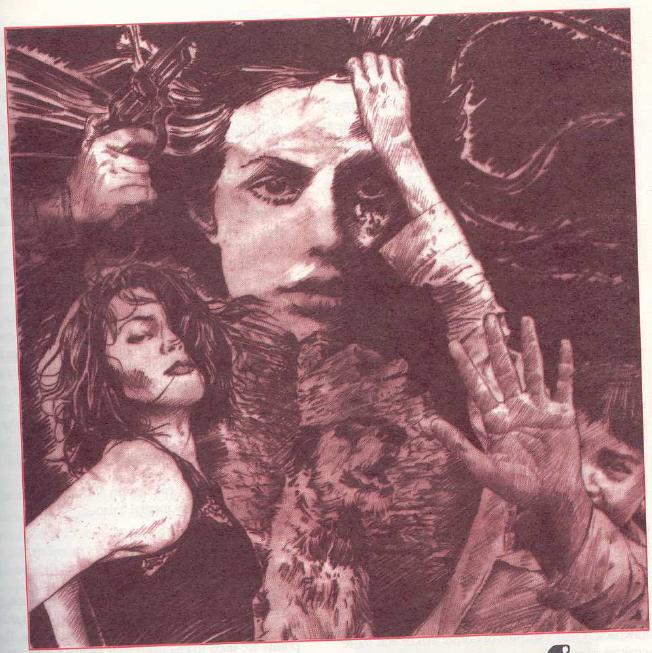
Kult, I will never understand your art.
This is the part where the game starts to show a few cracks. As per usual, Disadvantages give us more points to play around with for skills, and Advantages give us less. Additionally Disadvantages give us less Mental Balance, while Advantages give us more.
We're going to cap out on Disadvantages, of course. Mental Constriction, Intolerance, Touchy, Egotist and Bad Reputation. We're a huge asshole, and people know it. Having a Bad Reputation somehow makes us mentally unstable, more than having a hair trigger(Touchy), as much as mental trauma(Mental Constriction) and jackassery(Intolerance). -40 Mental Balance. Delightful! We'll see what that means soon enough. But before that, let's look at some of the Disadvantages and Advantages.
Generally the Disadvantages are stuff that means someone hates us(Animal Enmity, Bad Reputation) or that we do stupid things(Death Wish, Fanaticism, Drug Addiction), with some twists on some of it. Nightmares don't just make us sleep poorly, some creatures can use them as pathways into the "real" world.
There's Sexual Neurosis, which is a fancy word for "you have an unsettling fetish," thankfully it comes with a footnote:

Sadly we all know this is probably something that people need to be reminded of.
And then Sexually Tantalizing. I'll just copy-paste it.
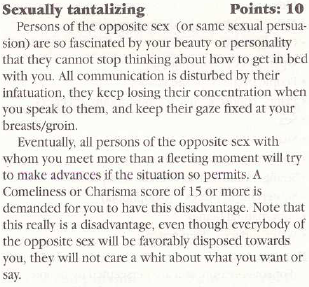
So, again, note the 10-point thing. That's as much as a Death Wish, being a Fanatic or being Forgotten(basically you're so bland that no one ever remembers you. Though if anything, that seems like it could be incredibly useful at times, you don't WANT certain people remembering you clearly). You take as much sanity damage from subconsciously wanting to kill yourself as you do from everyone checking out your tits and wanting to get into your pants.
And then there are the Advantages, none of these are particularly weird, a lot of them are just badly thought-out. While they boost your mental balance, a lot of them give you what are undoubtedly weaknesses, yet still COST you skill points.
For the sake of example, there's being a Pacifist or Chivalry, the former meaning you NEVER hurt anything, the latter meaning you will White Knight as hard as you can for any women(it says Ladies, but also says that at least half of all women should count as such, by whichever definition you use). Compulsive honesty or generosity, forgiving all bad things done to you, that sort of thing. The sort of thing that could either get you into trouble, or which could make getting out of trouble challenging.
It does specify that these things make you well-liked, but being well-liked isn't going to save your ass when you refuse to fight back against someone who's trying to stab you. But, at any rate, the main point of this is to affect our Mental Balance.
Mental Balance
In a game about going crazy, sanity and its associated mechanics have got to be pretty core. In Kult they're probably more at the heart of the game and its setting than in any other.
High Mental Balance makes us resistant to shock, obviously, while Low Mental Balance makes us susceptible to it. Specifically, it says, if our Mental Balance is under -75, if we get severely shocked and fail an Ego roll it will "contort" our character's body. That sounds bad.
At -40 we cross the -15 and -25 thresholds, the former of which makes us scare animals and children because we're just so inherently CREEPY, and our insanity is so severe that it makes our body function abnormally. At this point we're also capable of attaining Magical Intuition, an Advantage that lets us screw around with magic. That's right, to cast magic you need to either be staggeringly insane or staggeringly sane. Note, though, that Magical Intuition nudges your Mental Balance up by 20, so a crazy guy wielding Magic would need to be REALLY damn crazy, considering that most of the mental illnesses or disadvantages we can strap ourselves down with are at most a -5 or a -10.
At -50 a psychiatrist would be able to figure out we're mentally ill. Meaning that we can be severely depressed(-15) with a Death Wish(-10), a severe habitual liar(-15) and have an obsessive oath of revenge(-5) and still we'd apparently pass a mental health test with flying colours(we'd only be at -45). Apparently in Kult, psychiatrists are incompetent or just plain assholes who don't care if we go shoot ourselves in their front office.
At -75 we get the aforementioned body-changing effects when we get shocked, and we stop being able to control any unfortunate results of our Disadvantages. Normally we might be able to rein in our intolerance or egotism if our life was at risk, but under -75 we just start being completely driven by our desires.
At -100... "your light side takes the form of a light shadow that follows you and attempts to contact you." We're told to see the section called The Awakening to find out more about this.
High Mental Balance is basically the exact inverse of this. Everyone likes you, creatures with a really low Mental Balance prefer not to hang around us because we're just too stable(predictably, a lot of demons and the like have naturally rock bottom Mental Balances). At +100 we get the advantage Body Control which... isn't in the advantage list, uh. Also we "can no longer use force or feel destructive aggression in any situation." And of course we get a DARK SHADOW that's going to show up and meet us, a "materialization of our repressed dark sides."
For all the advantages at lower levels, it rapidly starts to look like being TOO sane is a major pain in the ass as well. The chapter rapidly cuts short here before telling us anything about these shadows or magic or anything else about it. Seems like we'll have to wait a bit longer to REALLY figure out the repercussions of these choices.
Rules on how we go insane and lose mental balance the "natural" way are also delayed until later, forty pages later.
Skills
Three kinds of skills, Basic, General and Academic. Everyone has a minimum score in Basic skills, anyone can learn General skills, but Academic skills are reserved for those with an Education score of 13 or higher. And we're finally introduced to yet another consequence of what stat choices(or rolls) we might have made earlier.
This is vaguely alluded to in the Abilities chapter, but it's only at this point it's elaborated on. Essentially every Skill has a related Ability. Normally it's 1 for 1 to improve, but if we want to improve a Skill above the related ability, it's 3 for 1. So yes, this means we can be an eagle-eyed marksman despite being legally blind, as long as we're willing to invest the points in it.
After a bit more about how skills are used(with opposed skills you have to beat the opposition's "effect," the difference between their roll and their skill score), we get to the big list of skills. Instead of having some sort of easily searchable format, for instance being alphabetic, the skills are sorted under their governing ability, and are STILL not alphabetic under there.
For example, the order the Agility skills are in:
quote:
Climb, Projectile Weapons, Sneak, Dodge.
If anyone can point out the governing logic, please feel free to clue me in because I am fucking blank.
The Basic skills are most kinds of combat, dodging, sneaking, climbing, swimming and reading/writing our native language. Thankfully we start with skill equal to our Education in that, meaning we don't have to invest any points to avoid being an illiterate.
General skills continue the shape of being completely irrational in organization:
quote:
Dancing, Parachuting, Falling Technique, Craft, Sport, Martial Art.
Again I invite someone to puzzle out this order for me, because I can't. Maybe in the original Swedish it's an alphabetic organization and they didn't bother to re-order the skills after translating? Anyone know?
There are some oddnesses on the skill list, like Scuba Diving, Estimate Value and Written Report. The first seems like it could fit under Swimming, the middle one like it should be part of any skill related to a craft and the last like is odd because it already tells us that writing something WELL is part of the language skill for what you're writing in.
It should also be noted that ALL Charisma skills are General, not Basic, so unless you expend points in it, your character is essentially a stuttering social cripple. No skills at all are based on Comeliness, so it kind of seems like the odd one out, the one that has very limited effect, with even Endurance mattering some for how much hurting we can deal with. Comeliness doesn't even get invoked under the description for, for instance, Seduction.
It also starts becoming obvious that while some of these abilities are very niche, others are extremely useful and anyone would want to have them, like Double Shot. Succeed at an Agility check and you manage to fire two bullets with one attack, and neither suffers a penalty. Apparently screwing up the Double Shot roll just means you attack normally.
Martial Arts : Kult only has four: Karate, Jujutsu, Kendo and "Commando Training." They apparently get a chapter of their own, so no call on whether they're ridiculously broken or not quite yet, but they're pretty expensive. We start with 150 points(for a normal character) and it's 20 just to be a student, with any actual special abilities costing more. For the same cost you could be a crack shot with just about any firearm you want.
Being a Master or Grand Master of martial arts allows us to screw around with "Ki Forces," if we purchase the appropriate skill. Maybe Kult will allow us to have Wuxia fights with demons? That'd be awesome. Especially since Commando Training is apparently included under the martial arts that allow us to unlock Ki Forces.
Astrology's a skill, but it straight-out says in the description that while the Astrologer can believe he sees patterns and figures something out, it's all bullshit, the skill is worthless. Apparently even in Kult, some things are just too stupid to be true.
While Astrology is total bullshit, we're told that Numerology (which is also a skill, of course!) can totally find out cool stuff that can serve as seeds for adventures. It describes the results as "amazing coincidences," but apparently they're still more valid than amazing coincidences involving the movement of celestial bodies.
Pictorial Arts and Photography are apparently separate enough to require entirely different skills. How often in games would that difference be RELEVANT?
The Academic skills are largely uninteresting, Humanities, Sciences(Natural and Social) and Medicine. The only interesting thing is that it says someone with Medicine can perform surgery, then in the next sentence says he doesn't necessarily have any idea how to treat sick people unless he also has First Aid.
All in all, the Skills section isn't TOO insane, but there are some weirdnesses. You can easily take Mad Scientist as an archetype, but completely and utterly lack the necessary Education score to actually know any Natural Sciences. Some of the skills are admittedly useless(Astrology) and others are ridiculously specialized despite costing as much as the rest(Scuba Diving vs knowing how to handle a firearm or drive a car). And of course there's the rather miserable organization that tells the alphabet to go get fucked for no good reason.
Since she apparently never got a proper education in medical science, our Mad Scientist makes do with an extensive knowledge of Poison & Drugs(a skill that apparently doesn't require any knowledge of science or pharmacology to be excellent with), First Aid and Electronics(can't have a Frankenstein without some way of channeling lightning), as well as the requisite skills to hear the mob coming(none, actually, spotting stuff is 100% just Perception, no Notice skills!) and defend herself from them(guns, guns, guns).
Assuming that 15 is a good stat to have in any of them, in order to assure that we can rely on them...
12(Handguns, being a basic skill, starts at 3) + 15(Poison & Drugs) + 15(First Aid) + 15(Electronics) + 12(Dodge, also Basic).
After making sure we can defend ourselves and have a decent selection of skills at a high chance of success, we've not even used up half our pool of skill points. Basic Kult characters aren't pushovers, there'd easily be room for some social skills and some basic ability with some other things(driving, sneaking, etc.). So it doesn't seem like they messed it up.
Next time we take a poke at equipment/funds(Mad Scientists apparently make mad bank) and beyond that, the chapter used if people want to play monsters instead of just normal humans.
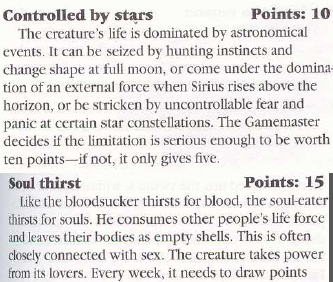
And they said Astrology was useless!
Less excited about the possibility of fuck-vampires, though.
Character Creation 3
Original SA post
ProfessorCirno: Note that there is no noted point at which a positive mental balance will indicate you as insane, even at the point where you are physically incapable of taking violent action against anything, for any reason.
Kult!
The Lie: Character Creation(almost done with this, I promise!)
Living Standard
Our starting money and resources are determined entirely by a trait called "living standard," I crawled around and could find no way our living standard cost us any points, and as far as I could tell it's ENTIRELY determined by our archetype.
It's a scale of 1 to 10, and Mad Scientists are between 5 and 7, putting them at a place where they're comfortably well-off. Enough money to pay the bills and still do a few medical experiments on hobos for fun. Comparatively, a character with the
Outsider archetype
would have between 1 and 3, literally MAKING him one of the hobos that the Mad Scientist injects with weird poisons and serums.
The only thing that archetypes really "restrict" is essentially your recommended Dark Secrets and Disadvantages/Advantages, so there's no reason NOT to be a Rock Star to get that 6-8 Living Standard range that'll let you roll up to the first session with a rocket launcher in your guitar case.
Equipment

Alright, maybe not, but if we're playing a game set in the US the game still informs us that "almost anybody other than an ex-convict" can arm themselves up from the get-go.
After a brief explanation of weapon calibers and how some things are illegal to own as a civilian, the game then proceeds to give us a face full of tables. Four pages of them, of which three are weapons and weapon accessories(including explosives and tear gas) and the remaining one is cars and a bit of miscellaneous equipment largely focused on computers and burglary.
At this point we have not even had a glimpse of the combat rules(which the book has merely described as "a bit more complicated" than the basic resolution model) and this section doesn't make it any better. The only thing it tells us about the pages and pages of weapons is caliber, availability(do you need a license or to know a shady dealer?), ammo capacity, length and weight.
Yes, length and weight.

In case anyone wants to nitpick realism, the length is in centimeters and the weight is in kilograms. Personally I just find it hard to think of a game situation where I need to know that my pistol is 21.6cm long and weighs exactly 0.95kg. I suppose it's possible we'll be bumping into some spells and rituals later on that are VERY picky about the dimensions of what they affect. I think most likely we'll find that this is completely irrelevant data that could have been better replaced with, say, damage values, to spare us having ANOTHER table for that later on.
The list of cars, instead of giving us, say, maximum speed and acceleration, tells us instead their horsepower and cylinders.

This is the list of miscellaneous equipment.

Some things may need to be updated for a modern game, but largely the equipment descriptions don't yield anything horrifyingly wrong or hilarious. Though it's good to know that the most powerful personal computers in the world have Intel 486 processors. Those are some true monsters of computing force.
There is some odd tech disparity in the available equipment, however. We can, for instance, purchase an "active camouflage" suit that'll let us pretend to be the Predator and even hides our smell from stalking animals or monsters. But the "lie-detector" is still an old-fashioned polygraph. There's also a "movement detector" which isn't elaborated on, but which is presumably something like the motion detectors out of Aliens.
Experience & Practice
The short section on levelling up and awarding XP. Unlike a lot of games, it starts off not just telling us to reward good roleplaying, but to actively penalize "lousy roleplaying" with XP penalties.
We're also allowed to increase any Ability but Comeliness and Education just as long as we did something impressive with them over the course of a given adventure. Further cementing Comeliness as the useless one of the attribute group. It does nothing and we need plastic surgery to even improve it after character creation. Screw you, Comeliness, I'm going to go hang out with Strength and Ego.
Other than gaining XP from adventures, we can also gain XP from practicing during our characters' "down" time. This XP gain costs money. Once again, being a
Rock Star
is shown to be the only legitimate archetype choice. Even with the middle of the Rock Star's range of Living Standards you could, with the noted costs, easily gain 20 or more Ability points to play around with. Considering that average characters start with a base of 100 for Abilities, and 150 for Skills, that's a pretty big lump.
(Also by now I've linked or in-lined most of the archetype art, so I can reveal that yes, every single archetype picture is white. No asians, arabs, black people or anything else)
Finally we're revealed what our ten "Hero Points" are for. They basically function like Moxie or Fate points or whatever the local game's equivalent are. You can use them to cockblock others' actions or boost your own.
And of course the game informs us that we get Hero Points for Surviving, being Brave and Skillful and... for acts of selfless Heroism. Well, shit, guess The Mad Scientist isn't getting many Hero Points, what with that Egotism disadvantage. At least she gets to start off with most of the game's armory and a Honda Civic.
And now, finally...
Beyond Humanity
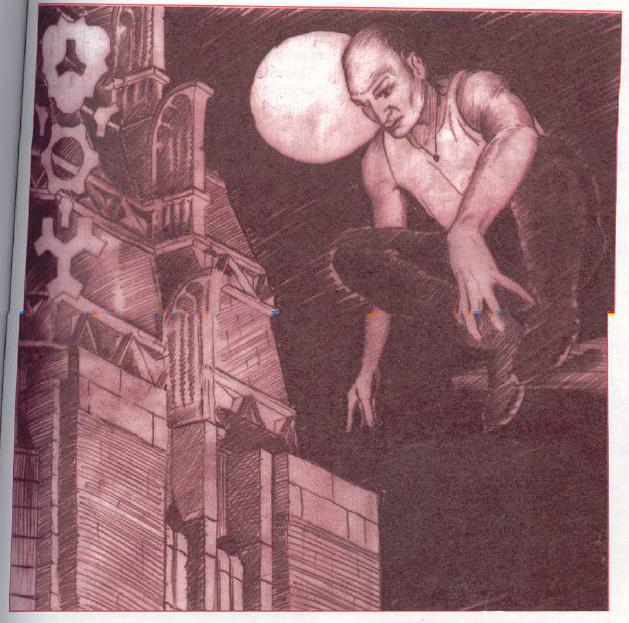
Oh yes, it's time to see what this game lets us do for making MONSTERS.
If we make a Beyond Humanity creature we're doomed to to a low mental balance, they've got Limitations and Powers, but while Limitations drop their mental balance, Powers don't raise it, oh, and every Beyond Humanity creature must have no balance higher than -25. At least this guarantees that we can play with magic if our Mad Scientist is also a vampire or something.

Note that Soulthirst was the aforementioned "you fuck people's souls out and eat them" Limitation.

Being a Child of the Night/Beyond Humanity creature(the text uses the two terms somewhat interchangeably) also sticks you with it as an archetype on top of whatever you have before, but it only adds more things, it doesn't change the basic stuff like living standards, so if you want to be a vampire with a Ferrari, you have to be an undead Rock Star.
The Limitations we're then presented with are a bunch of generic weaknesses, really. We can have our lifeforce stored away in an object(Symbol Bondage), be zapped extra hard by electricity, turned to dust by sunlight, have to fuck people's souls out to stay alive, have to EAT them to stay alive, that sort of thing. We can also be incredibly ugly.
It also quickly becomes obvious that this stuff makes you remarkably powerful even if we just take the first Power on the list. Commanding Voice. Basically we can tell anyone to do as we say, and unless we're asking them to kill themselves, they have to roll under half their Ego with a D20 in order to not obey. Remember that normal characters would have their Abilities capped at 20, so in a worst-case scenario we've got 50-50 odds of making someone our slave.
If
we're asking them to kill themselves, they just have to roll less than their Ego. Assuming 10 is the average in a given score for a human(with 2d10 being the roll for any stat for an NPC, it would seem close to the bell curve center), we've got 50-50 odds of making most mooks just off themselves at our command.
Oh, and it affects everyone who can hear us and understand our language. And if someone resists, they're not immune to our voice of command, just to that specific order. It's also not an expensive power, costing only 15 of our 150 starting skill points, and considering that it basically auto-wins us any fights against any humans, and doesn't even require us to be attractive, charismatic or have a high Ego of our own... it's a pretty good deal.
Things are once more out of alphabetical order, and we read about Natural Weapons before Invulnerable to Weapons. The former gives us some combat rules that don't make sense considering that we
haven't the faintest damn clue how combat works yet
. None of the other abilities are particularly interesting, we can have tentacles and claws, be immune to things as opposed to vulnerable to them, telepathy, infinite endurance, etc. Commanding Voice was really only worth noting because of how absurdly powerful it was. All in all, a pretty disappointing sub-chapter, especially considering how creative some of the ACTUAL monsters are(or how creative I recall them to be).
And with that, we're finally through the section on character creation, and step unto the threshold of the game's second section, The Madness, where we're finally told what all the abilities and equipment we have can actually DO, how we play the game, and, right off the bat, how our characters react to maddening events.
Next up: Meeting With Terror! And more!
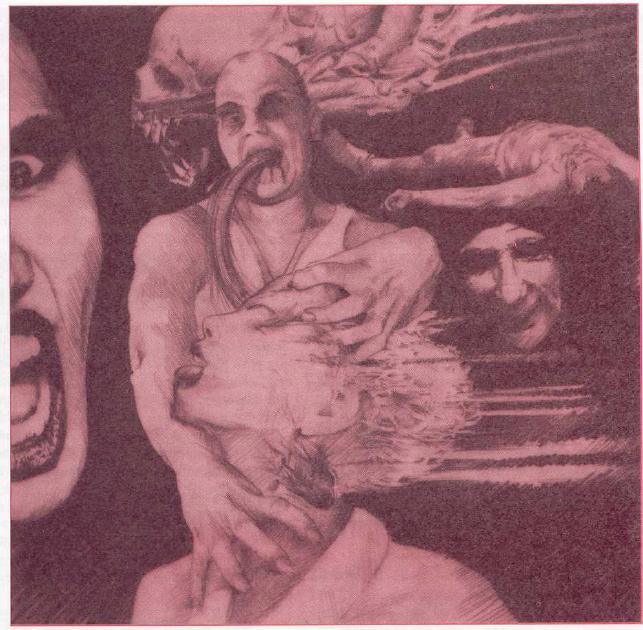
Vampires and cursed demonic machineguns ahead!
Mechanics 1
Original SA post Kult!The Madness! Also known as the "this is how you actually play the game"-section.

This is the art that greets us, along with a short story about someone being murdered by the depicted, horrific, vampiric creature. Delightful!
Appropriately enough for the chapter name, it starts us off with "Meeting With Terror," the section that's about being horrified and losing control. Unfortunately, that's about as far as the good stuff goes. Instead of invoking the GM in some good methods for creating horror(beyond the advice "don't spew out horrifying stuff all the time, it'll lose its impact") or the players in some related roleplaying, it's mostly dry mechanics.
If you've got a Positive Mental Balance, shocking events affect you less, and if you've got a Negative Mental Balance they both affect you more and they become harder to resist. Our Mad Scientist has a -40, which affords her a +5 penalty(+'s are penalties because we're trying to roll low, if you remember). The shock check itself is essentially trying to roll under our Ego with a bunch of modifiers piled on. For anyone without a sky-high Ego(it'll cap out at 20 unless we're a Child of the Night with some form of boost to it), +5 is almost certain to give you less than a 50% chance of making it. For a game about horror, that's almost the point at which your character may as well stay home, especially considering that most events(unless they happen all the damn time around you) will give you a further +5 or +10 to avoid being shocked.
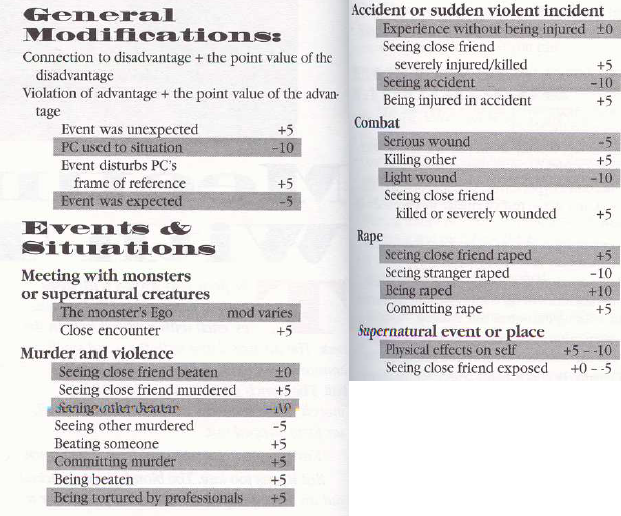
Of course there are some exceptions.
For instance, if it's a stranger that's being raped, not someone we know or ourselves, we can just sit there all day, munching popcorn. The brutal murders of people we don't know are also relatively un-scarring, as are accidents that don't actually HURT us, no matter how gory they are.
Obviously part of it's to make sure that characters don't tap out every time something spooky is going on, but some of the modifiers still seem a bit ill-decided.
So what happens if we actually screw up an Ego roll to avoid getting terrified? Any character who isn't a high-positive balance character will scream, weep, faint, go into catatonic shock or run away. On top of that, characters with negative mental balance and disadvantages "lose control" of them. They become expressed in some extreme manner. The guy with Animal Enmity(animals hate him) starts murdering dogs, Egotists... become more egotistical, it essentially becomes exaggerated and cannot even be suppressed for the character's own safety's sake.

Then there's this thing again, which just keeps seeming like a really bad idea to let any player take.
Limitations for Children of the Night can also go crazy that way, which kind of presents an issue with them. Any Child of the Night will have at most -25 Mental Balance, and probably a lot less, and on top of that they're likely to be involved in a lot more violence, and be around a lot more horrifying things, than normal humans, making it almost guaranteed that they'll lose their shit and have a hell of a lot of trouble regaining control. Of course, if the player WANTS a permanently insane character, that's cool, but it would probably render the character useless for anything other than an NPC if he becomes a maniacal dog-killer for the rest of his life.
There's also the issue of what happens when characters with a mental balance of -75 or less fail an Ego roll(with a +15 penalty even BEFORE modifiers from the actual event, they may as well not even bother making the roll): They lose control of not just their disadvantages, but also their body. Their disadvantages, one or more, manifest in some sort of physical way. The specific example given is someone terrified for her life whose skin changes into an iron-hard carapace.
The concept is actually pretty interesting and adds something more to the sanity mechanic than just being terrified or going insane, your character could permanently become something monstrous.
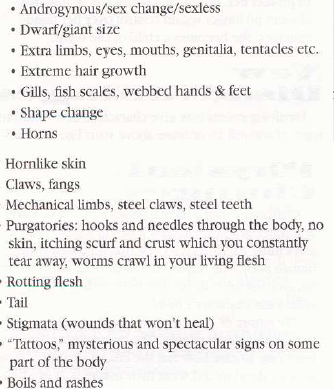
Either that or your GM may have read the book in detail and decided it's more appropriate for you to sprout "extra genitalia." Now you're insane AND you have five cocks.
On top of that, screwing up a roll REALLY badly, missing it by 10 or more, no matter our mental balance, drops another Disadvantage on our heads. It's not "if the gamemaster thinks it's appropriate," it just happens. And no, we don't get any free skill points out of it, it just screws our mental balance downwards and generally gets in the way. If your character is already a little bit crazy, odds are they're going to get a lot crazier, and it's going to go faster and faster.
On top of that every time we fail an Ego roll to see if we get shocked, we have to make another roll to see if we see true reality. And then if we fail THAT we have to make YET ANOTHER Ego roll to see if we somehow screw up reality just by seeing it for what it really is(like corpses springing to life around us).
Essentially, as soon as the scary stuff shows up, the whole thing degenerates into a mess of rolls. This may be terrifying if the clattering of dice triggers a phobic reaction for you.
One roll for initial shock, one roll to see if you can keep your shit together temporarily(for instance to get out of the way of something huge and monstrous), one roll to see if you get another disadvantage, one roll to see if you "see through the illusion," one roll to project your inner demons on reality and then, presumably you'll want to do this, a roll to disbelieve said projections and make them go to sleep again. So between 1 and 6 rolls just for a single shocking event.
Possession
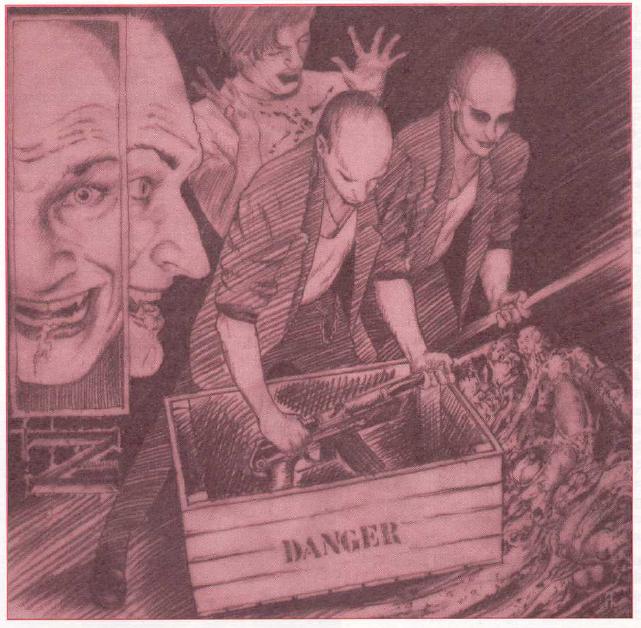
This picture accompanies a short piece of fiction about a guy who finds a cursed machinegun and kills his friends with it after it speaks in his mind and tells him how this would be an AWESOME idea.
Predictably there are monsters that can possess us, and predictably, again, having a low Mental Balance screws us over here as well. It's all decided by opposed Ego rolls, and both of the example creatures they've got for this section(yes, there's no true beastiary, instead creature entries are just scattered around sort-of where they'd seem appropriate) have a minimum of 10 Ego, and up to 20 or 40, depending on which it is. Throwing either at the PC's with an attempt to possess would in essence present a very cruel save-or-die roll that would most likely result in "die."
The role-play example is the bit from the story before, where someone grabs an object, it possesses him because he fails his roll, and then he murders his friends with it. That definitely seems like an exciting way to lose a character. Right?
Purgatides
The first, and lesser of the two creatures, is the Purgatide. Sadly there's no art of them, but they're essentially escapees from hell who are pursued by Nepharites(which we've yet to find out what are). I can spoil you, though, that Nepharites are tough assholes and as a bonus fuck-you if a Purgatide possesses you(with his 11 to 20 Ego he has decent odds), the Nepharites won't just yank him out of you and go home with him, they'll tear out your spine and THEN collect their missing prisoner.
At least, though, you're back in control as long as the sun is up, though the Purgatide takes over again at night.
Etheraces
No such luck with these ambiguous, poorly-defined spectral beings. They've got an Ego between 13 and 40(yep, fuck you, player), and as soon as they possess someone they basically start partying and generally engaging in as much fun and other tangible things as possible(including self-mutilation, just because it FEELS like something) and will wear out the host's flesh in about a year. Oh, and they DON'T fuck off during the day, like Purgatides do. So screw you if it happens.
Exorcism
A wizard could help you get rid of the intruder, however, or a psychologist could do it if someone straps you down and he has 1d20 days to chat with you. You get a second ego-save out of that, and you add his Effect(difference between his roll and his Psychology skill) to it. Which is still unlikely to save your ass if it's an Etherace, better hope you know some wizards, I guess.
Ultimately, these two could be kind of interesting if they're used to possess NPC's and cause trouble in that form, like if one of the PC's friends suddenly starts going crazy because there's a Purgatide in his head, and they have to get it out before the Nepharites catch up.
But as something for the PC's to deal with directly(which is obviously intended since it has rules for the PC's making saves to avoid possession), they're just completely horrible ideas.
Combat
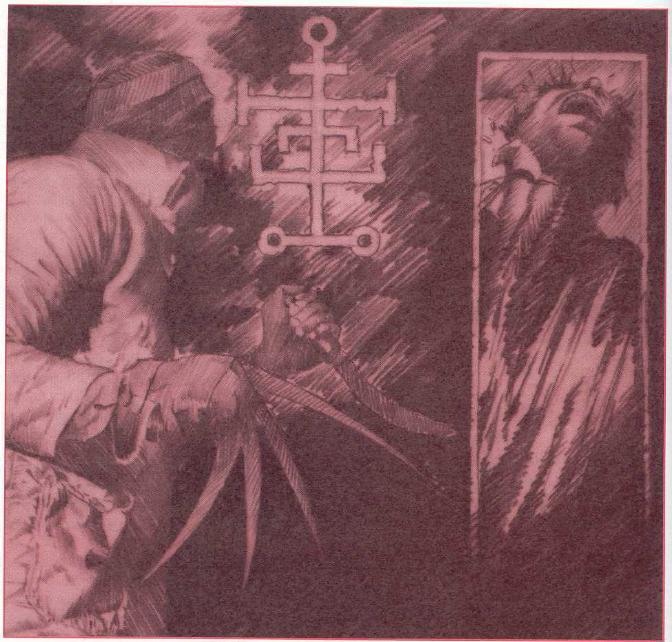
But, ultimately, if we really had to, we could use Etheraces and Purgatides intelligently, and we could roleplay our way around a lot of the sanity rules if they sucked. What would be more difficult would be to invent new combat rules from scratch if they're broken. So let's see if they are.
Actually using combat skills is just like any of the other skills, which is a good start, a simple roll-under with a D20, penalized if you're aiming for something specific. Bland but functional.
Parrying in melee is, oddly enough, apparently not an opposed action. You just roll to see if it succeeds and then block 1d20 damage(reading the later bits this seems like they wrote it poorly and intended that you'd lower the roll of the incoming hit by 1d20).
Damage is a separate roll, yet another damn D20. Depending on what we roll, we can cause one of four severities of damage. Scratch, Light Wound, Serious Wound or Fatal Wound. Instead of having static damage modifiers or bonuses, the way weapons work is that bigger, nastier weapons will do serious and fatal wounds with lower rolls, while smaller weapons are more likely to do scratches and light wounds. Oh, and this D20 is arbitrarily one we want to roll high on.
Any single Fatal wound is a kill. Usually this requires an effect of 16+ or something, so it's rare, but it does mean that most things can die from a single, really good shot. Our Constitution determines how many it takes of the lesser injuries to add up to one bigger one, and eventually to one Fatal that'll off us. It's not a bad idea in theory, but...
Most people will be able to take a few dozen Scratch injuries before keeling over, even the characters with rock-bottom constitution scores, and even for firearms, an Effect of 1-4 or 1-5 is usually what'll cause a Scratch. So it's not completely implausible that you can take a dozen 9mm bullets without dying. For example's sake, let's take someone with a Con of 3, being shot at by a guy with an Makarov, which has 1-6 for its "scratch" range. The most basic armor, like a leather jacket, would increase the "scratch" range to 4-9(with 1-3 being no injury at all).
At Con 3, it's 3 Scratches to a Light Wound, 2 Lights to a Serious and 2 Serious to a Fatal that'll kill you. That's exactly 12 Scratches, meaning it's not completely unfathomable that even the frailest character is going to walk away from almost a dozen bullet wounds. But at the same time the Makarov also has 16+ for its "Fatal Wound" range meaning that it could instantly kill you in the first shot, making combat completely and utterly random. There's a small side-rule about injuries also losing you Endurance, which means that if you're doing all the book-keeping, you may pass out before you die, but that just adds to making combat seem like something for accountants instead of players. There's also a random roll for what body part we hit, meaning that we're up to three rolls just for a single attack. To hit, damage and which part we hit. If we were in melee or using a throwing weapon we'd also be adding in a dodge or parry roll for our opponent. And the basic character has two actions per round, so that's one(if we miss) to four(a melee attack that hits), times two, 2 to 8 rolls per character per round, with more for faster characters.
One of the first things the chapter mentions is also the penalties for aiming for specific body parts, but I cannot for the fucking life of me find out if hitting someone in the head actually DOES anything other than circumventing their armor if they're only wearing a vest and not a helmet. This proceeds to make things sillier as our example character from earlier could now take ten bullets to the HEAD and still be twitching.
We're also told that hydrostatic shock only occurs when we're shot at by "machineguns," but to the best of my knowledge it's a phenomenon which is also going to increase the hurt if you get hit by an ordinary pistol. Someone may feel free to correct me on this.
Piles of specialized rules follow and the game starts to lose track of whether +'s are penalties or bonuses, and while all of these special things affect your odds of hitting, none of them affect what damage you'll do, meaning that it remains frustratingly random whether you kill someone in one shot or hose them down with ammo only to find them still flipping you off.
Also, while parrying is mentioned in the Combat chapter, Dodging is only mentioned, described and provided rules for back in the Skills chapter. Goddamn this book and it's complete absence of sensible organization.
Initiative! 1d10+an Agility modifier and for the first time in the game you want to roll HIGH instead of as low as possible. It's totally great to invert the game's logic every now and then.
I'm not even completely through Combat and I've barely even poked at actual equipment yet, and it's already looking like kind of a mess. So I'm going to take a break and tackle the rest of it in the next post(assuming there are any more dumb things, I'm predicting I'll be able to find at least a couple).
In the meantime, enjoy this art for the start of the Martial Arts section.
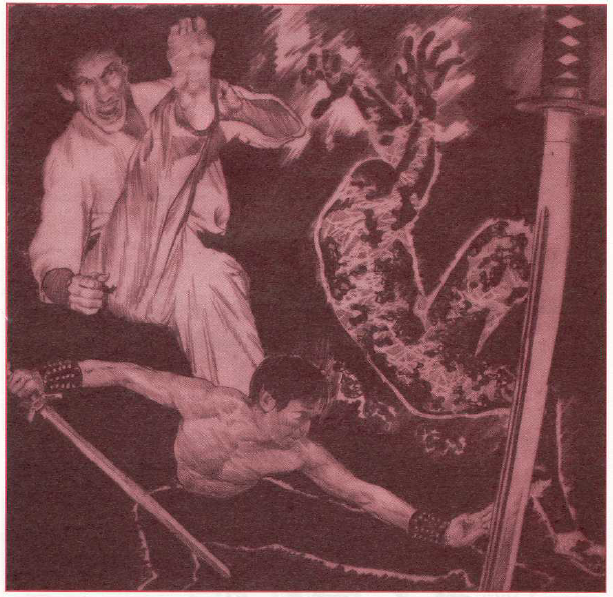
Mechanics 2
Original SA post Kult!The Madness: Continued.
With combat largely dealt with, it's time to take a look at equipment(weapon stats! Excitement!) and martial arts(there's some crazy here).
The first thing to notice is that, with damage done completely divorced from how well you hit, any random guy on the street who hits another guy with a kick has a 1-in-20 chance of just killing him, assuming no one's wearing any armor. If the guy who's making the kick has even vaguely decent agility and strength, that's going to increase rather fast.
Normally it requires a throw of 20+, our Mad Scientist has 16 Strength, 17 Agility, that adds up to 33, checking a table we see that gives us a +4. If we walk up to someone on the street and kick him in the gut, we just need to roll 16 or higher to kill him. 25% chance, in other words.
Most pistols, revolvers, automatic rifles and submachinegun weapons have that same range for their Fatal wounds, meaning that we're essentially kicking with all the force of bullet. Suddenly it starts to feel like we're playing Exalted. Just wait until we get to the Martial Arts section. Firearms do of course have the advantage of range, though most submachineguns start racking up penalties to hit and damage at just over 10 meters. Remember that distance for the next chapter.

No interesting art for this section except for some reasonably competent drawings of a large number of the guns available. I'm not enough of a gun nerd to know whether any of the statistics are completely absurd.
Though it should probably be noted that katanas do as much damage as firearms(before considering any strength/agility bonuses) while fire axes and broadswords actually lean more towards doing as much damage as a solid kick.
So let's just get to the martial arts, because that's where things get SILLY.
Martial Arts

Admittedly, the art was kind of a warning.
Let's say we want to make a badass Karate expert, we'll pay up in character points to give him 20 Strength and 20 Agility just so he can really tear ass through enemies, and we start him as high as we can with martial arts, as a Master(we need 30 in those stats to make him a GRAND Master, but this will be enough to make him absurd from chargen).
It overrides our melee skill if we want to punch someone, that skill is now stuck at 20, meaning that we're highly likely to land any punches we throw. This is awesome already. We also get a +5 to our effect rolls and a further +4 from our high strength and ability. That's a +9 which will serve to make our damage REALLY goofy. Kicks do more damage than punches and we'll have an 18 with those, still good odds of hitting someone.
With our +9, it's now 11 or better we need to instakill someone with a single attack.
We can buy some Budo Maneuvers that'd make it even sillier(like attacking three times in a round or basically making our kicks area-effect weapons), but that isn't enough, let's go Supernatural, let's check out the KI FORCES and, hey, hang on...
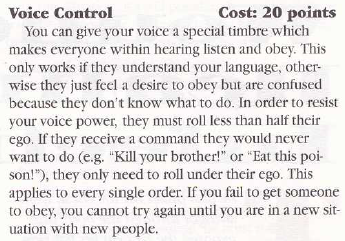
This looks awfully familiar! It's not just for vampires any longer! Purchase that and anyone we can't instantly kill with a kick we can just mind control. It's admittedly a bit weaker because we can't just rephrase our order every time, but it's still silly. None of these Ki-Force powers require any sort of checks to use on our part, mind you, or drain any sort of limited reservoir of power. So we can sprint through crowds yelling at people to kill themselves and half of them will probably do it.
There's also Air Attack which makes our unarmed attacks(or armed attacks, if we bought Kendo, which gives us all these silly bonuses with SWORDS, buy a katana and we can kill people just by looking at them from across the room) ranged, letting them hit targets up to ten meters away. Which is the range beyond which a lot of firearms start getting penalties anyway.
Ki Forces are essentially the supernatural stuff you don't have to ask your GM for permission to buy and on top of martial arts, you can break the game pretty fast. That Katana suddenly kills at a 6 or higher, you've got a 20 in the skill to attack with it, and it can make armour-reducing strikes.
Miscellaneous Stuff
Next we've got some boring rules for injuries and healing, nothing staggeringly weird or funny. Accidents and falling, not too odd either, except that tripping over your own feet about a 25% chance of causing a Serious Wound, which borders on the fatal. A one-meter drop on to a stone floor can kill you instantly.
There's the poison table, in case you want to see what poisons exist that can all effectively instakill you from a single dose. The rules are kind of wonky, though, as the table provided and the start-of-section rules say that you lose a given amount of Con after a single dose(which you can survive and recover from, assuming the GM doesn't roll over your con, which there's reasonable odds of), while the poison descriptions themselves(for instance for nerve gas and carbon monoxide) say that you just die within X minutes, fuck you.
Then there's the table of drugs, including ones you can overdose on if you failed a shock roll, grew a beard of cocks and realized you want out before the GM starts reading the martial artist rules.
Time and Travel chapter, in case you REALLY want to be obsessive about how long it takes to drive across town or sprint across a street during a combat round. Noteworthy only for the fact that it encourages the GM to start fucking with the players using time travel.
We skip the vehicles chapter because it's more boring tables. This is starting to feel like AD&D. But thankfully there's something to save us just ahead!
Magic!
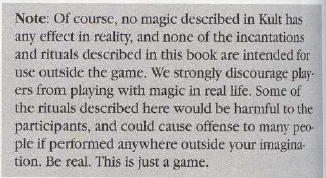
After reminding us not to go sacrifice our siblings or housepets to summon dark creatures from the netherworld, we're warned that we can only play with THESE things if the GM lets us, and then shows us a pair of new archetypes. One of them's boring, the other one is the perfect choice if you want the rest of the players to band together and murder you.
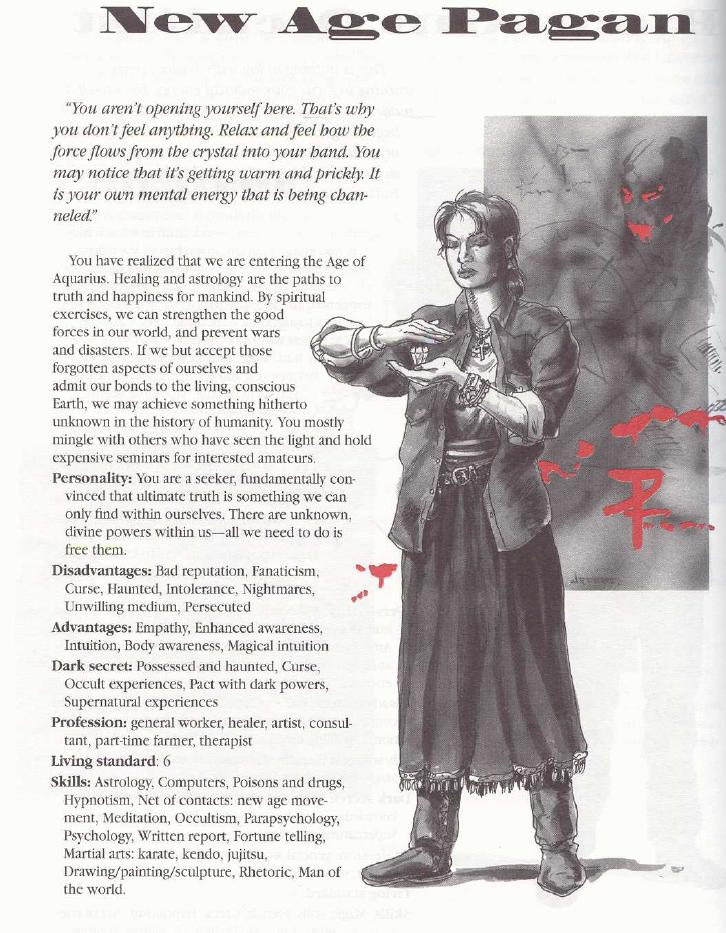
Six "lores" of Magic to play around with.
Madness: Fuck with people's heads and summon weird creatures.
Time & Space: Break causality and make your GM cry as you disassemble everything resembling logic. Also summon weird creatures.
Dreams: Go fuck with people's heads while they sleep and summon weird creatures.
Death: Necromancy, calling collect to Inferno, that sort of thing. Summoning weird creatures.
And... oh boy.
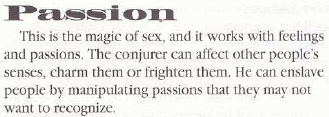
Allow me to append my earlier statement: Play a New Age Pagan archetype with the Lore of Passion if you want the other players to strangle you dead within the hour.
There's also the Lore of Reality which we can play with if we master all the other five and the book helpfully tells us to fuck off, that's not gonna happen, so they're not bothering to add any spells for it. Maybe it's in a supplement somewhere.
Outside of specific requirements for a given spell, they also all make you wicked tired. That's about it. Doesn't make you insane(though you have to be a bit crazy to learn Magical Intuition in the first place), doesn't give you permanent wounds, etc. all in all relatively merciful.
Unfortunately we can't just roll up and start throwing fireballs, all spells are ritual magic that require us to bunker down in a specially prepared "temple" sanctum and start being magical nerds.
Before this post is done, let's crack through the Lore of Madness and see what interesting things are hidden there.
The Lore of Madness
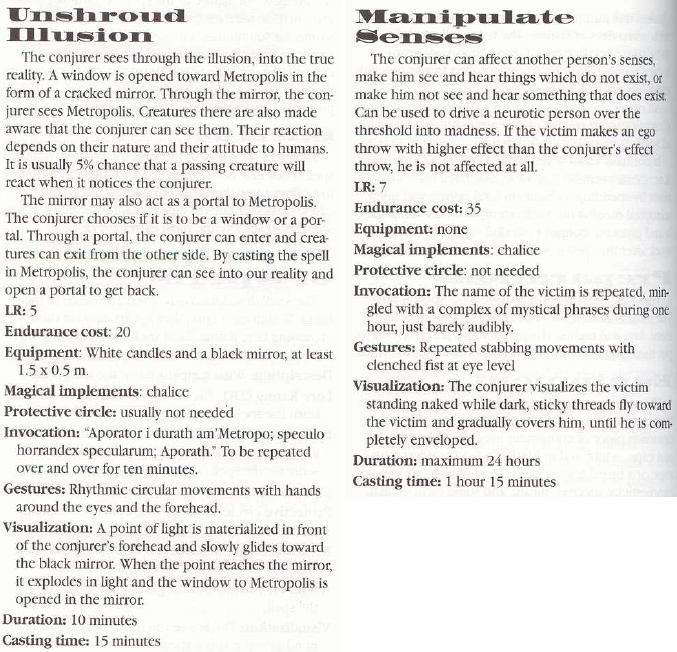
The basic power object of Crazymancers appears to be the pimp chalice. By waving it around and mumbling like a hobo we can either spy on extradimensional monsters milling around in Metropolis or drive someone insane. The latter is pretty hilarious and, considering that we don't even need to make a voodoo doll or anything similar, actually pretty powerful. If we know who our villain is, we can devote every evening to fucking with him for kicks until he's a crying wreck of a man.
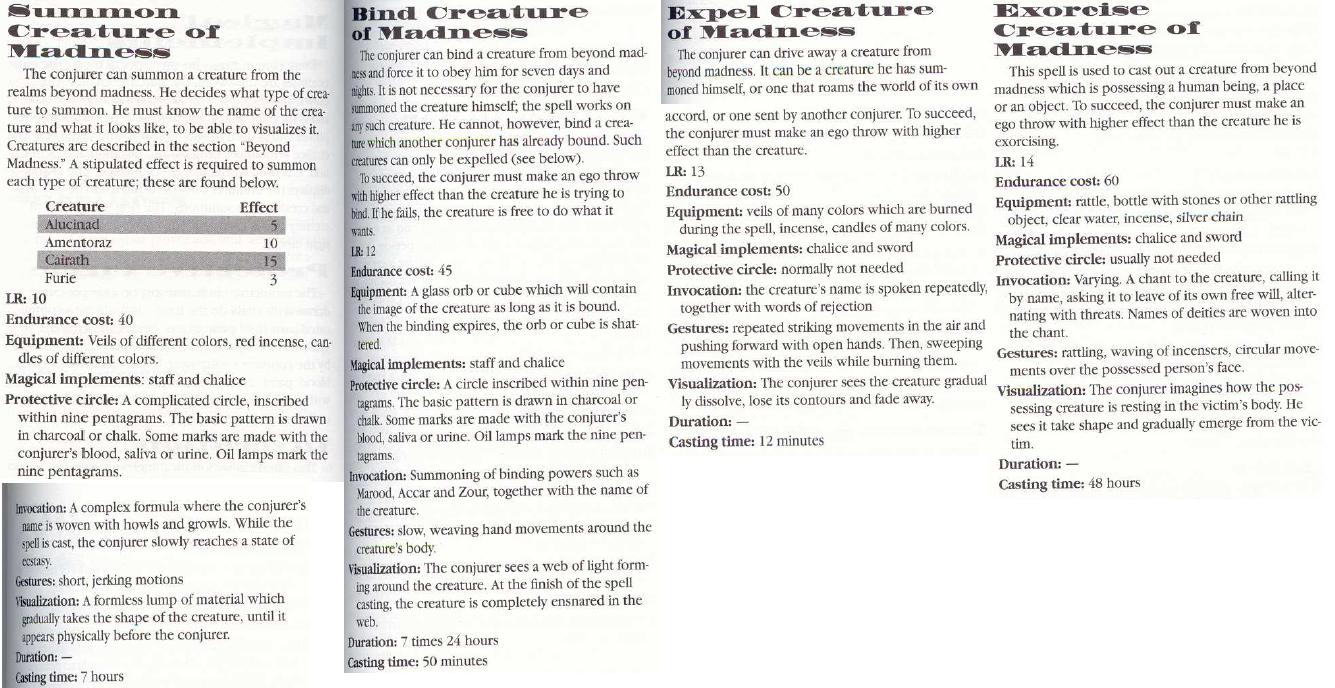
We don't know what these creatures are yet(that's coming up in the final big chapter which is all setting info and creature stats), but being able to kick them around like redheaded stepchildren sounds pretty handy, especially considering that we just need to duck into our Wizard Closet and dance for about ten minutes to get rid of them again. Considering that Binding and Summoning together take about 8 hours, and last for a week, we could actually rustle up a small army of nasties to do stuff for us in short order.
We'll probably also want to have some cleaning materials on hand for once we're done summoning, though, y'know, with that circle of piss on the floor.
All in all it's relatively fast and not too challenging to do(though we're going to need a high Ego if we're going to play around with this shit). Still a couple more spells to go, though, hang on!
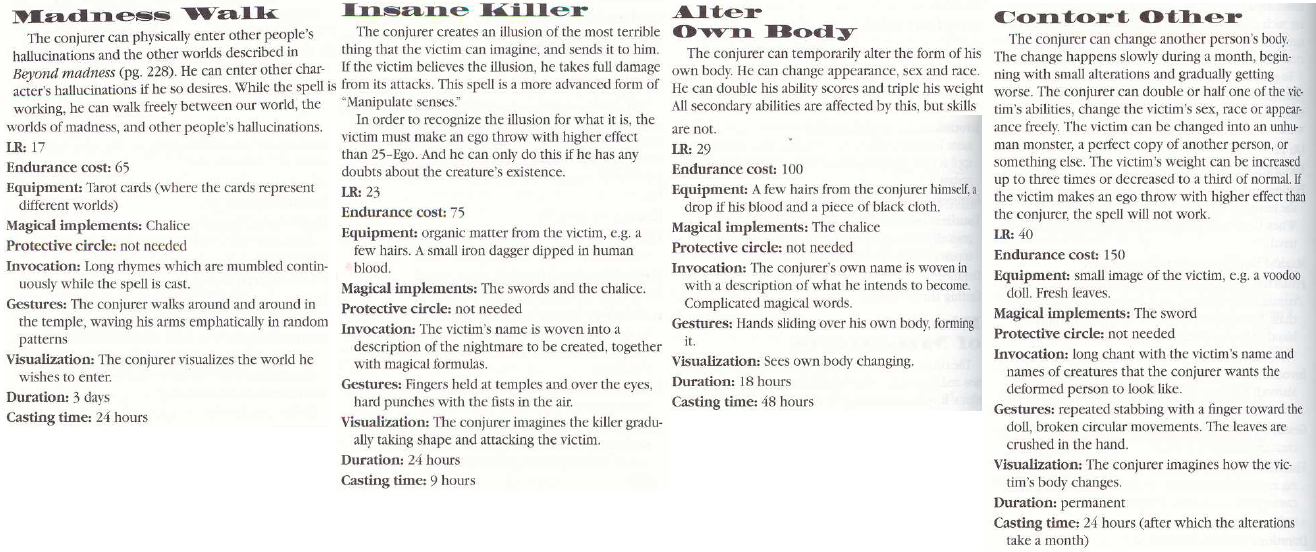
The final three spells are going to be out of reach for most PC spellcasters unless there's a group of them casting together as a coven or they're getting help from other Crazymancers.
Insane Killer isn't something that NPC enemies should ever have, since the roll to not be Completely Fucked is pretty grim unless he's got quite a high Ego. But it could be a good story component, the PC's can't take down an NPC on their own, but if they can just get a bit of his blood they know someone who's willing to conjure up an Insane Killer to take them down.
Alter Own Body is pretty powerful, and exactly the sort of thing that an NPC Crazymancer could bust out for a boss battle. They slam their way into his inner sanctum just as he finishes the last invocation and erupts into a monstrous thing that can really give them a run for their money.
And Contort Other is the sort of grim invocation that can affect PC's or NPC's they care about and send the part off on a race against time before someone is permanently ruined.
All in all, aside from Passion Magic, which I'm still dreading getting into, the Magic chapter is off to a decent start. It's not useless, it's not superpowered.
Next post I'm going to finish pouring through the Magic chapter and then get to The Truth, which is all the gooey fluff stuff that makes or breaks the game.
Mechanics 3
Original SA post Kult!The Madness: The final bits of magic. Let's get this over with.
Because I know you guys are just so eager to get to the Magic of Passion. Well, tough cookies, it's the last one part of the section, so you have to wait till the end of this post.
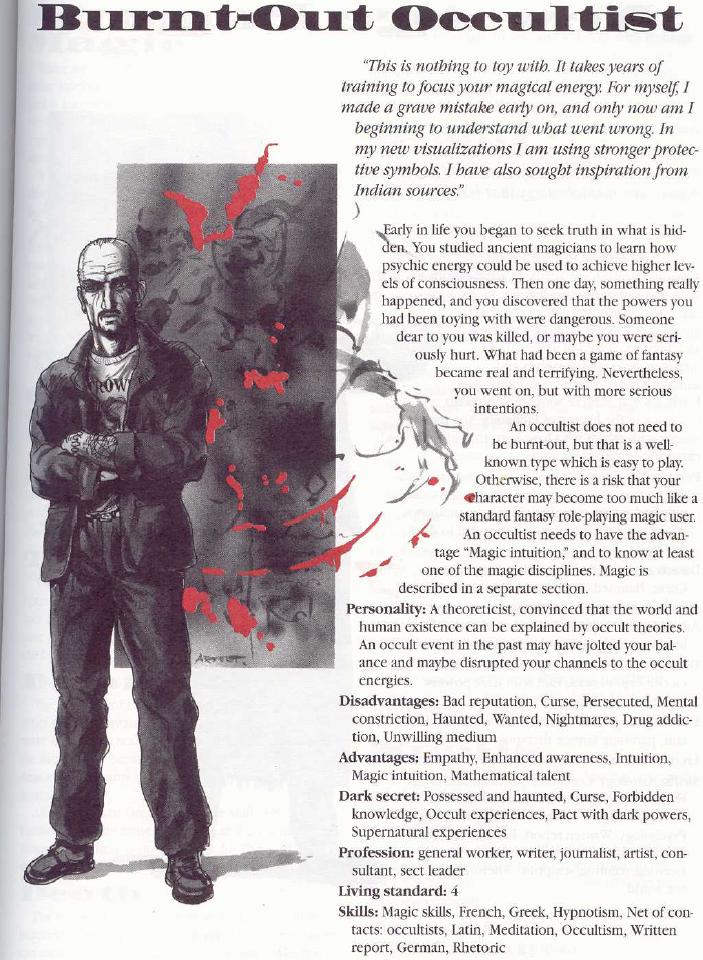
This is the other suggested arcane archetype, by the way.
So, last post I said that the magic system was generally well-considered, but on closer examination it does have some flaws.
You need a -25 or +25 Mental Balance, only buyable at chargen with Disadvantages and Advantages. Magical Intuition itself is a +20 Mental Balance change, but the way it's written, if you're going for Positive Mental Balance you should technically get +25 first and then add MI on top, for a total of +45. You could balance this out with some negatives to avoid spending almost a third of your skill points just to unlock magic. But that's already 20 points of Disadvantages if you want to balance that out, making for a pretty messed up character.
It doesn't say what happens if you have a just-on-+25 Mental Balance character who picks up a Disadvantage from Shock and drops into the middle sanity levels. Do you lose your magical abilities? Depending on your GM, you might! So maybe you don't even want to do that.
On the other side of it, at -25(where you'll technically need -45 worth of disadvantages, quite a shitload of crazy to avoid Magical Intuition bumping you up into the non-crazy ranges), you're at the point where just about any encounter with terror is going to rapidly nudge you towards unplayable levels of madness and physical mutations.
Here's the disadvantage price list if anyone wants to juggle around what levels of insanity they'd need for a mage. Of course there are a few physical/social downsides as well, but being Maimed or having a Bad Reputation affects your sanity and reactions to shock just like being depressed or having a split personality does.

Then after Magical Intuition you need to learn your chosen Lore(or Lores) like a standard skill, which is another investment that's likely to run you 10 or 15 points, you certainly don't want to be low on Ego or Lore skill rating when you're trying to exorcise or expel a Razide or something that you summoned.
And then there's the fact that...
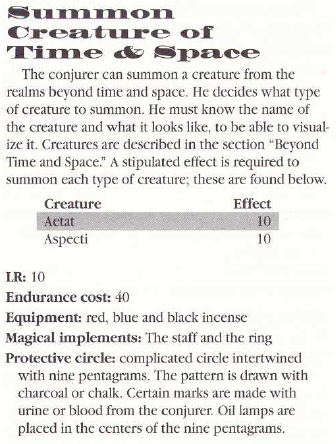
Doesn't this look familiar? Yep. Just about half of every Lore is the same set of four Summon, Bind, Expel and Exorcise spells that could just as easily have been rewritten as one spell at the start or end of the section. Only two things differ, how much resistance the summoned creatures have to being called, and whether you're using the Crazymancer's pimp chalice, the Space Wizard's ring, Dream Mages also get a pimp chalice so they don't even have that difference, Necroguys wave a stick around and Bonerologists get a sword(Freud, etc.), they also get to throw more incense and shit around, though.
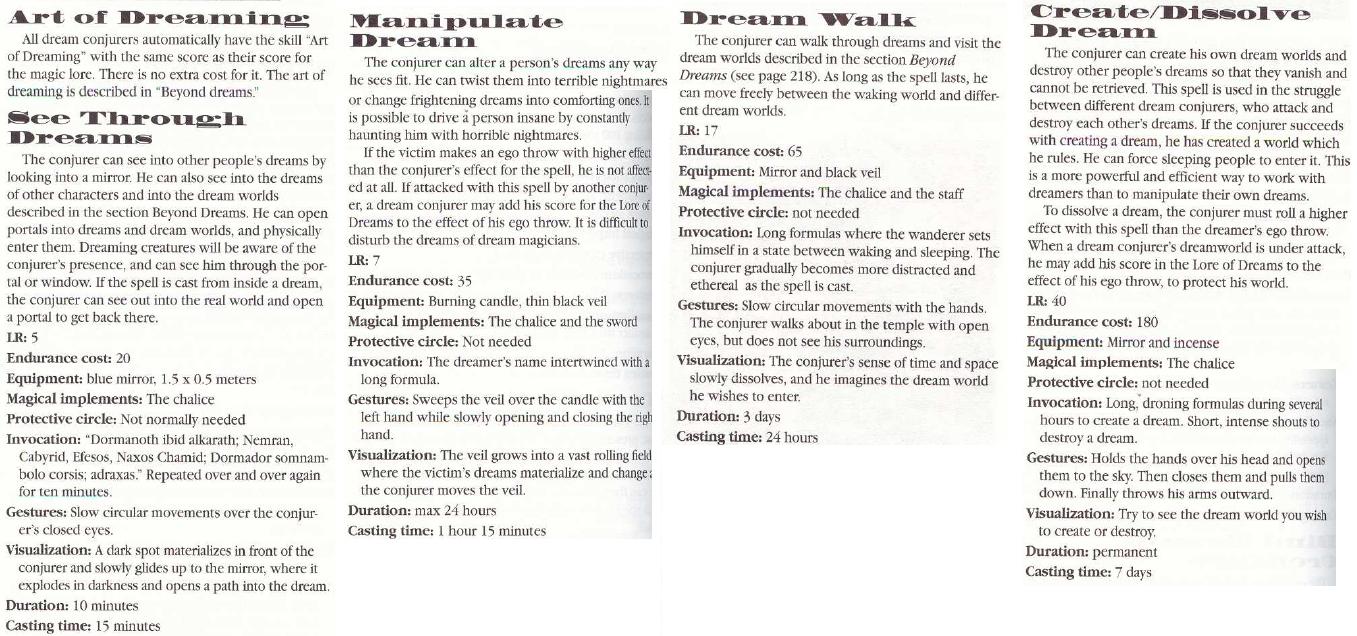
With the summoning cut out, Dream Mages can help us drive a Cadillac of Rock & Roll Guiles and Mad Scientists over a rainbow and into a world made of dreams. Or they can help the Crazymancer completely fuck with someone's head. Give him horrible nightmares while he sleeps, and then the Crazymancer makes them hallucinate parts of the nightmare following them into waking reality.
Also the See Through [Lore Name] spell is also reflected in every lore. Predictably for Time & Space it lets us see places and times in our own reality, and go to them. That's correct, the basicmost Time & Space spell is literally time travel, fuck you causality. Death lets us hop to Heaven or Hell. Passion's is slightly more interesting, so I'll actually be showing that one off.
But first, Time & Space.
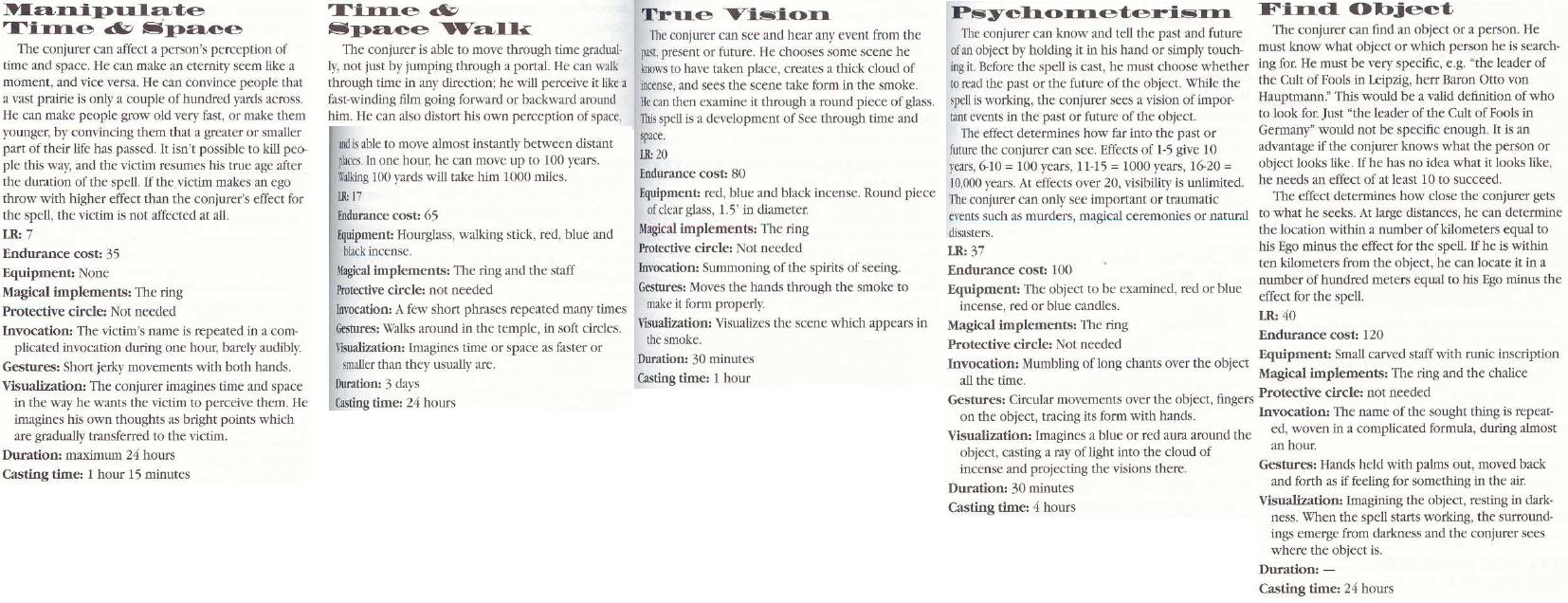
As mentioned, we start off being able to travel through Time & Space relatively effortlessly and accurately with See Through Time & space. Then we get another spell for helping make people feel crazy. Then we get even MORE accurate Time Travel and then... three spells that we'll need to be vastly expert sorcerers to use(LR is the Lore Rating, which is how many skill points you need in the Lore to be able to use a given spell. It's pretty unlikely that we'll start with anything over 20), but which only give us information we could just get by time/space travelling to the time/object we wanted to learn about.
Commenting on the gestures and such, we apparently manipulate time and space by shaking it until it says uncle, but other than that, nothing hilarious goes down.
Oh, and while you might consider that some of these powers seem awfully awesome for escaping trouble or dangerous locations, remember the whole Temple aspect. We literally can't cast any of these spells while we're away from home unless we have the time to create, deck out and consecrate a temple there.
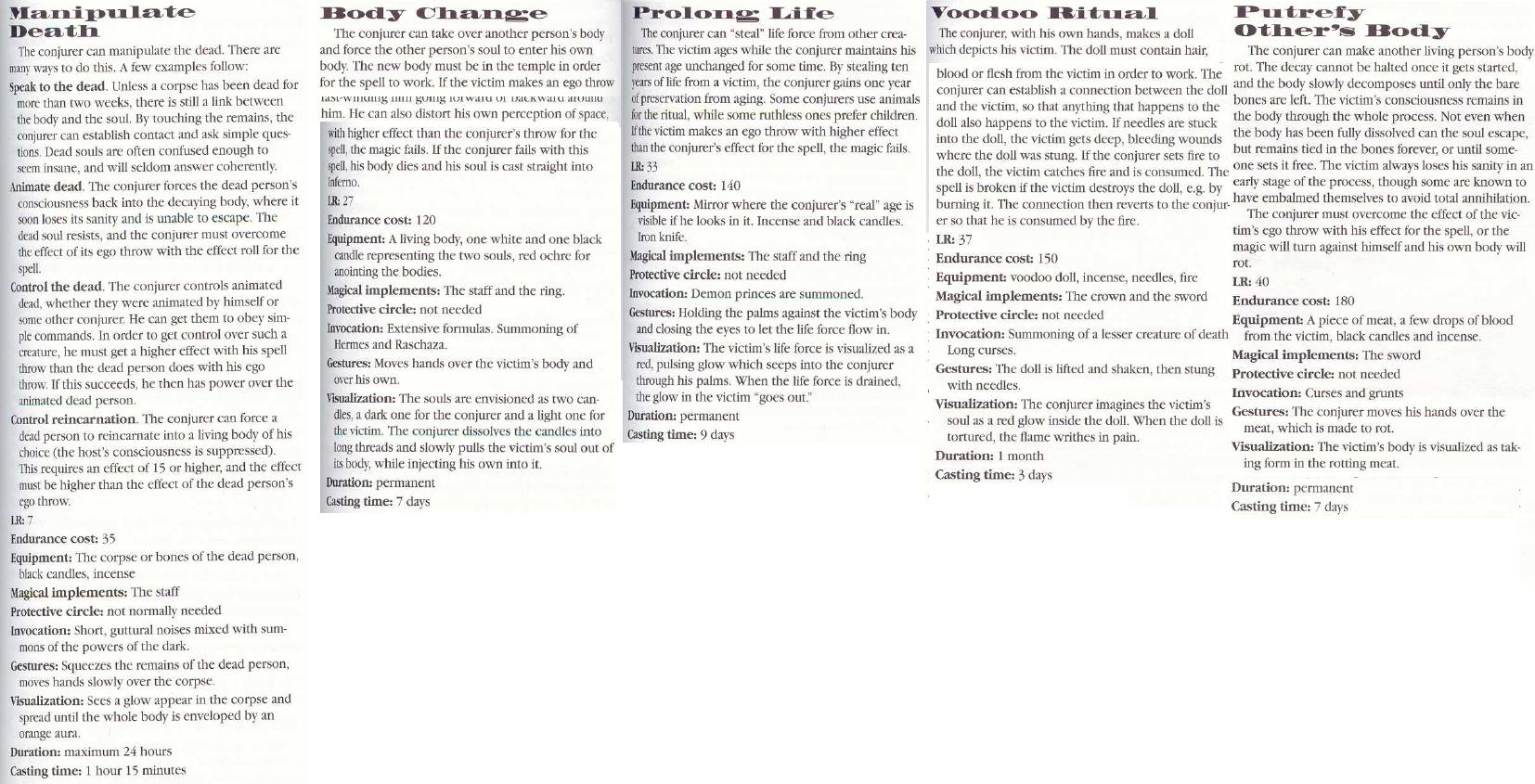
Necroguys start off with a cheap and relatively easy way to make zombie hordes and talk to the dead, pretty handy, but as soon as we're past the generic SummonBindExpelExorcise stuff, it's all things that PC casters are unlikely to get to play much with. Which is probably for the best, considering that half of them are "you're fucked"-spells(Putrefy Other's Body, Voodoo Ritual), but Prolong Life and Body Change are excellent things for villainous NPC mages to mess around with. Very classic occult-y stuff, and not suggestive of any strange fetishes on the designers' part. Of course, that's all about to change because...
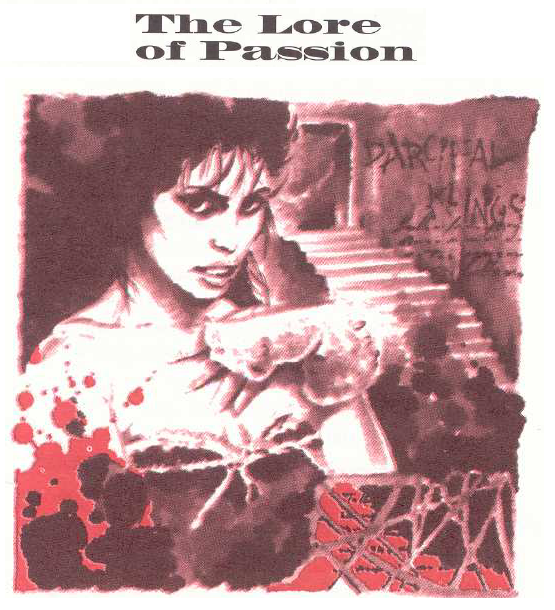
It's time for Bonerology 101!
Let's look what the crazy Kult designers have for us here. I bet it's going to be wacky.
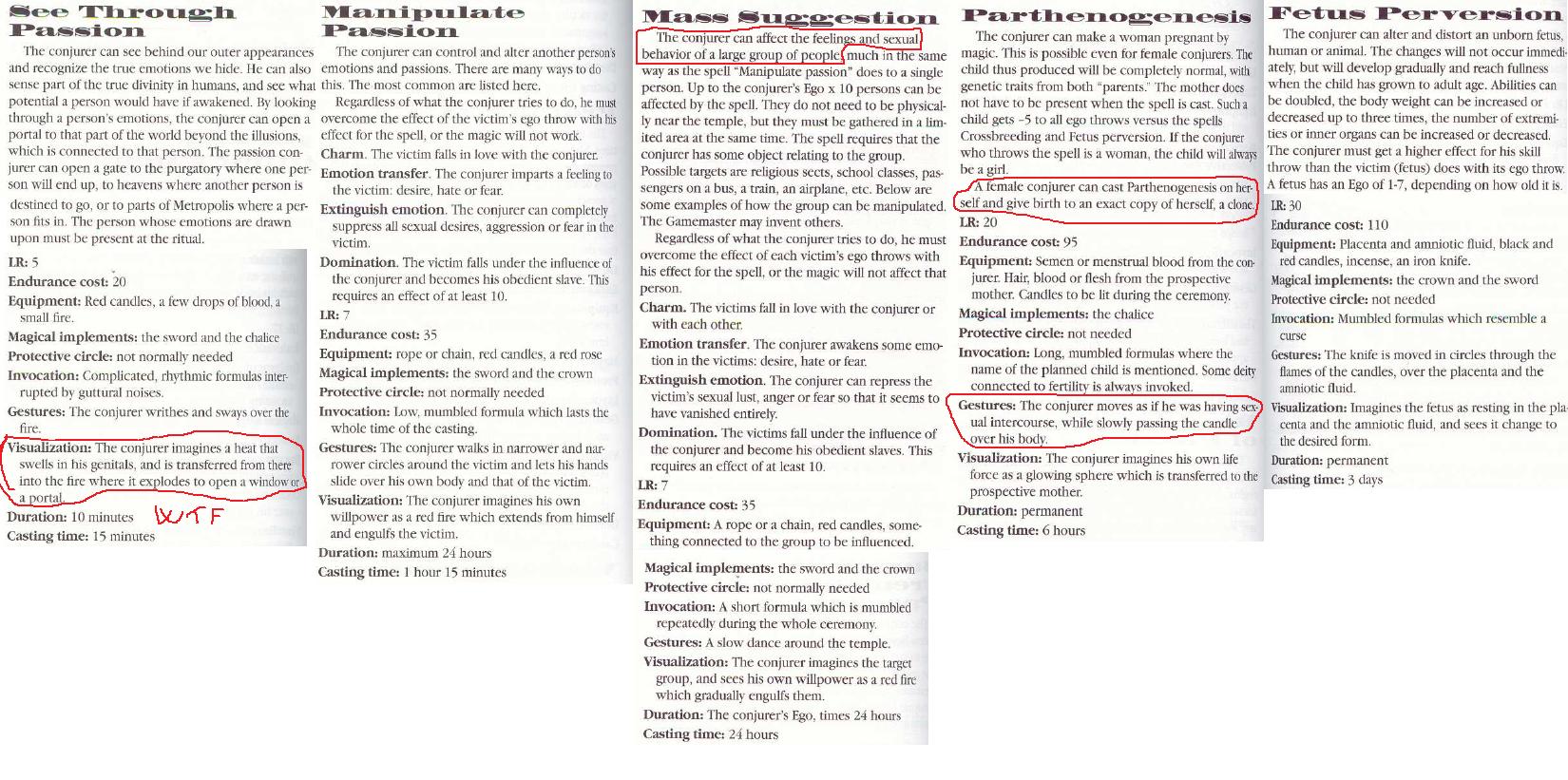
Well, they've got the obligatory bits where you can magically knock someone(including yourself) up or mind control someone into fucking. I guess it could really be WORSE. There is one spell that I find kind of hilarious and entertaining, however...
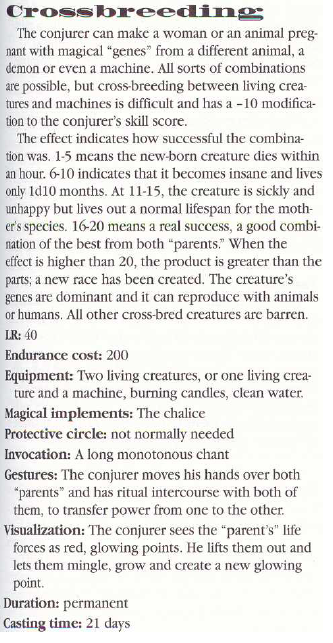
Fuck owlbears, we can make a toaster-fish, a tank-eagle or a turtle-elephant. Well, assuming we've got enough wizard buddies to buff our Effect or are just crazy-powerful on our own.
EDIT: Of course I overlooked the part where you needed to have ritual intercourse with both participants, thereby making my enthusiasm seem REALLY WEIRD. Let's just pretend I noticed that all along and am now horrified at my own suggestions. Gah.
That ends the official spells that we get to mess around with, some of them are powerful, some of them are interesting, some seem kind of useless or just a bit weird to use if you dislike things like mind controlling people's sex drives.
After that the game lists various forms of occultism: Alchemy, Astrology(USELESS NEVERGOOD), Cabbala, Numerology, Demonology, etc. but largely just gives a short, dry historical paragraph. It doesn't suggest how any of this stuff could be used to create new spells or Lores, or how maybe they could be alternate approaches to magic(maybe Demonologists summon creatures from Inferno and bind them to perform spell effects for them instead of going through tedious rituals on their own, maybe alchemists can raise the dead with strange mixtures and expand consciousness with the same stuff, a Re-Animator themed adventure would be awesome).
The only three "non-western" occult beliefs mentioned are Voodoo(as the only Latin American occult tradition), shamanism and tantrism. "All modern sexual magic originates in tantrism." Yep, really looking forward to Beyond Passion. Really .
And that FINALLY concludes the damn Madness chapter. Now we're on the home stretch, heading into the Illusion. After almost two-hundred pages of crunch, finally we get to learn about the game world and what we can DO with these numbers.
Coming next: The Illusion.
Setting/Story 1
Original SA post Kult!The Truth
Also known as where we're finally told any fluff beyond namedrops of horrible creatures, two-paragraph fluff stories and the very broad introduction in the first chapter.
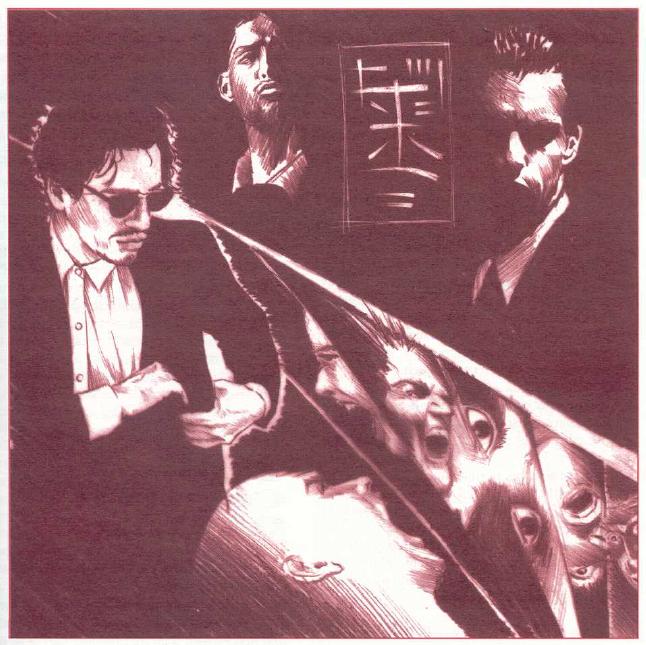
Predictably, the art isn't going to be any help in figuring out what's going on. The introductory fluff is in Kult's usual cheerful style: A woman has just completed some groundbreaking research in modifying human perception when some dudes in suits show up and murder her, and she plummets into Inferno.
The basic concept is that what we're seeing isn't the real world, or at least not all of it. Sure, our world exists, but we're failing to see the dozens of others that are folded alongside it. The realms of Dreams and Madness, the hundreds of futures and pasts, Metropolis and Inferno, the Heavens and bunches of others.
We're also told that a lot of what seems like coincidence is actually horrible stuff staged by extradimensional entities, or our own hate and misery becoming powerful enough to poke holes in the world and break stuff. The example for the latter is our own subconscious hate setting a gypsy's house on fire, while we think it's just some passing racist that firebombed it.
The things that make us see clearly are extremes of emotion and experience, and some places where fucked up shit has gone down(like concentration camps and torture chambers, or some crime scenes), the borders between neighbouring realities are going to be a bit thin in general.
Aside from picking on gypsies, this isn't too bad a start for a setting, and gives plenty of excuse for being able to haul in supernatural creatures all over. They're not living among us but SOMEHOW SECRET(looking at you World of Darkness), but are actually in neighbouring dimensions or possessing people.
The Captivity of Man
Then a history lesson, because it wasn't always this way.
Humanity used to be able to see all the worlds, and had downright godlike powers. Power over time and matter and the ability to reincarnate with all memories and abilities intact if we should happen to die due to accident, violence or stupidity.
As far as anyone knows, the one who ended this was the Demiurge, either some vast cosmic being or a single human that fucked the rest of us over. He basically trapped us in the Illusion and prevented us from accessing our powers by convincing us that they didn't exist, that we didn't have them. Further he also seeded most of the major religions because they encouraged us to not investigate the world but just accept that some vast being or pantheon of beings created it all and kept it running. This all happened way before recorded history.
Some time around the 18th Century, though, our Illusion started to crumble and the Archons, the Demiurge's closest servants, began to feed humanity science as an alternate explanation to religious creationism, not enough to let us start poking holes in the world or experiment too much, they hoped, but enough to explain away the holes in the religious "theories."
Then at the start of the 20th Century things go to hell for the Archons when the Demiurge just up and disappears. He disappears in such a complete fashion that many of his own servants aren't even sure he ever existed, or what he was like, and humanity's minds start soaking up science, atheism and crackpot theories at an increased rate as the concept of an all-powerful God, embodied by the Demiurge, is suddenly harder for us to believe in simply because he's gone.
On top of that, with no Demiurge to administrate things, the Illusion starts crumbling on its own. In places of great suffering, gateways to Inferno opens, in places of deep urban decay, we can pass into Metropolis, that sort of thing. The Demiurge has also been instrumental in keeping out a lot of "supernatural" creatures because they might clue us in to the past, but now that he's no longer doing that, a lot of our old slaves and pets, like the Azghouls(description still to come, this is like the fourth time they've been mentioned in the book so far with no descriptions at all) are cracking their knuckles and coming back for revenge while we're still weak.
Astaroth, the dark opposite of the Demiurge, who hangs out in Inferno, also gets worried, because without the Demiurge his own continued existence is in doubt. After having no luck finding him, he decides that the best way to make sure we don't wisen up is to gather up the legions of Hell and kickstart the Apocalypse, nuke all the science and learning out of us and pin us under some regime of ignorance once more.
So basically: Everyone who'd be fucked if we learned they were party to keeping us prisoner is scrambling to maintain the crumbling Illusion, and everyone who was kept away from us for our own sanity's sake is coming back to take revenge or just to fuck with our heads for kicks. It's not a good time to be human.
Lictors
With the Archons just below the Demiurge, the Lictors are just below the Archons. Apparently one Archon, Malkuth, created exactly 823,543 of the things, and I'm sure that's some sort of religious reference.
While the Archons manage all the big stuff about keeping us ignorant, the Lictors are the ones who possess humans or take human form to hang out in positions of power and make sure no one gets too interested in the true nature of reality, or any perception-changing stuff. They're described as "beings of passion and pleasure," that lack external genitals, are incredibly fat, and generally huge assholes. Otherwise they look vaguely human.
Despite being painted as horrible and dangerous things, though, their physical attacks(though they COULD just pick up an assault rifle) are actually "only" about as powerful as what Rock & Roll Guile could manage, making them legitimate challenges for the party. Assuming that the GM doesn't just have it use "Commanding Voice" over and over until it succeeds at mind-controlling the party.
The Archons
The Archons are all named after pieces of the Cabbalistic Tree of Life. Binah, Kether, Malkuth, etc. They claim to be more powerful than the Demiurge, which doesn't really hold water considering that they freaked out and fought as soon as he was gone, killing or exiling four of the original ten.
Kether : Kether used to screw around with us by being in charge of nobility, but ever since we got the idea of killing all the royals or reducing them to figureheads, he's mostly just been sitting around in his fortress in Metropolis, moping. He's supposedly "the mightiest" of the Archons despite doing fuck all unless his servants somehow manage to re-introduce feudal society to the modern world. Good luck with that.
Binah : Binah is Ayn Rand's nightmare, promoting values of the group over the individual at all times and keeping people tripped up with traditions that prevent them from trying new and potentially sanity-ruining things. She's directly, canonically to blame for Soviet Communism.
Geburah : Geburah is all about JUSTICE, that is to say, the sort of Justice where people get hung for doing anything wrong. He supports and probably invented the concept of the death penalty, and is basically cheerleader and funder for every crazy group of fundamentalists that want to implement Sharia law or Old Testament punishments somewhere.
Tiphareth : Tiphareth is The Plotter(tm), except even this book admits that no one has any clue what the fuck she's plotting, huge networks, ultimate power but doesn't really do much with it. Apparently the most dire thing she's doing these days is to encourage artistic expression. Not very impressive for a being of godlike power and immortality to all conventional means of destruction.
Netzach : This guy is in charge of armies and is apparently a huge, screaming hooligan looking forward to crashing all his mortal soldiers against Astaroth's legions of cultists and the undead. The Pentagon is also secretly a portal to Netzach's citadel.
Malkuth : And this is the only one of them that's not a dick in some way, because Malkuth has had a change of heart after the Demiurge died or ran away, and is now basically trying to help us all go insane enough to see the truth. Apparently she's not very smart, though, as some of her attempts to help us go properly insane involve causing atomic accidents to irradiate people. Hey, Malkuth, that gamma radiation isn't going to give the guy a third eye that lets him look into Inferno, it's just going to give him a fucking brain tumor.
Astaroth
Much like the Archons, Astaroth claims to be way more badass than the Demiurge ever was and to have been the one that created him in some fashion. In Inferno he's the general administrator of souls, but he also hangs around in our reality a lot as either the Antichrist(the guy arranging the Legions of Hell), The Seducer(basically a guy who throws orgies and knocks ladies up, then either makes them commit suicide or has them give birth to mutants) and The Beast(a hitchhiker who kills people).
All three forms have stats, but they may as well have written "lol fuck you." They each have several stats of over a hundred, will instakill you if they hit you with ANYTHING and can take ten Fatal Wounds. I'm not really sure what the point of them is except for them to be of use as GMPC's. They don't have any weaknesses, unless you count The Beast having only 1 in Education, maybe you can befuddle him with basic maths. Oh and if we get near them with a Mental Balance of under -50 we're instantly mind-controlled by them.
Astaroth could function as someone orchestrating the deepest events of a plot from somewhere far away, but if he's actually encountered, instead of just his servants, the players may as well just beat the GM to death with his own dice.
The Angels of Death
Basically Astaroth's version of the Archons, they've ended up out of a job now that the Demiurge is gone and Astaroth wants to conquer the mortal world. With people mostly not BELIEVING that they'll go to hell for being jackasses any longer, they don't even have as many "sinners" to torture for laughs any longer.
There's not much detail on them in the book, one(Thaumiel) is planning to rumble with Astaroth on Earth, a couple(Golab and Hareb-Serap) still toady for Astaroth, and the remainder are mostly indulging their weird and creepy hobbies.
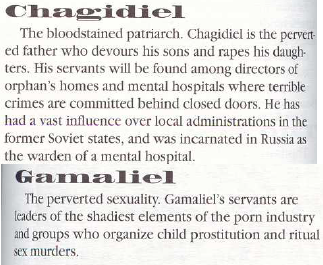
These sort of hobbies. The Death Angels are not nice people.
The remainder just support bad habits(like extreme revenge, religious violence, torture, necromancy) or run some institutions but intentionally fuck it up(like one guy runs aid organizations that get people killed instead of saving them). Except for their former job of dealing mostly with dead people instead of living people, they're basically like the Archons.
The Illusion Shatters
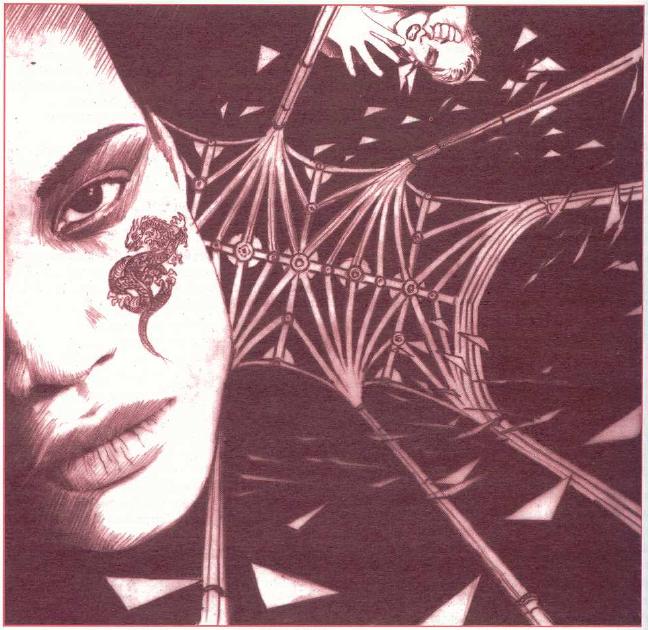
Intro fluff: Someone assembles a giant puzzle that sends them to another dimension. Not a puzzle like the creepy box from Hellraiser or anything. But literally a puzzle. One of those things with 5000 pieces that forms a picture of a boat. They could have picked something more intimidating.
This is a short chapter about what sort of portals there are, where they can lead you and what sort of gates usually lead where. Urban portals tend to lead to Metropolis, places with suffering and corpses tend to lead to Hell, portals in dreams lead to Dreams. Until the Demiurge there were apparently also a bunch of devices and other weird objects that could be used for gateways, like the aforementioned puzzle.
WHY this is so, considering that all the creatures from the other side could just walk over and no humans really had any clue the other side existed, I can't say. Presumably the Archons and Death Angels just left them around as pranks so people could stumble into Inferno and have their skin taken off.
There are magic glasses you can wear so you can see reality as it really is, cameras that take pictures of reality as it really is, mirrors that can also work as portals, movies and puzzles are also among the recommended. Anyone who's seen Cigarette Burns may find the idea of a "portal movie" kind of fascinating.
Fucking around with people's brains or juicing them up on all sorts of crazy drugs can also let them see through, or rarely step through, reality. This opens up a lot of freaky ideas of doctors messing with people's brains, and actually makes some of the drugs&orgies cults a little bit interesting instead of just the realm of creepy GM's.
The book also keeps referring to "desolate heavens," "abandoned paradises" and "confused seraphs," but unfortunately never really tells us much about these places or the seraphs themselves. Personally I would have been far more interested in hearing how Heaven fitted into the Kult universe than I would have been in hearing about the generic Hell(spoiler for when we get there: it's red and smokey and there are bad guys).
This part isn't quite as interesting as some of the later fluff chapters(particularly I always liked Metropolis), but at least serves to set the scene. We're beset on all sides by things that either want to kill humanity for fun or for revenge, or by others that want to keep us ignorant, so there's no one to go for if we want help, and supernatural creatures could be secretly involved in all sorts of otherwise "innocent"-looking misery.
Setting/Story 2
Original SA post
For those commenting on Kult being very Hellraiser-y/Clive Barker-y:
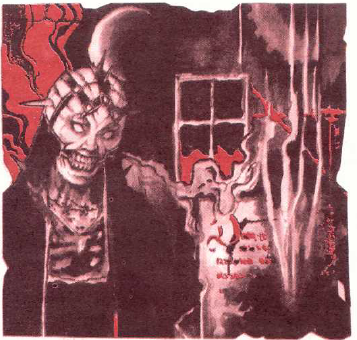
Pretty blatant.
Kult!
The Truth
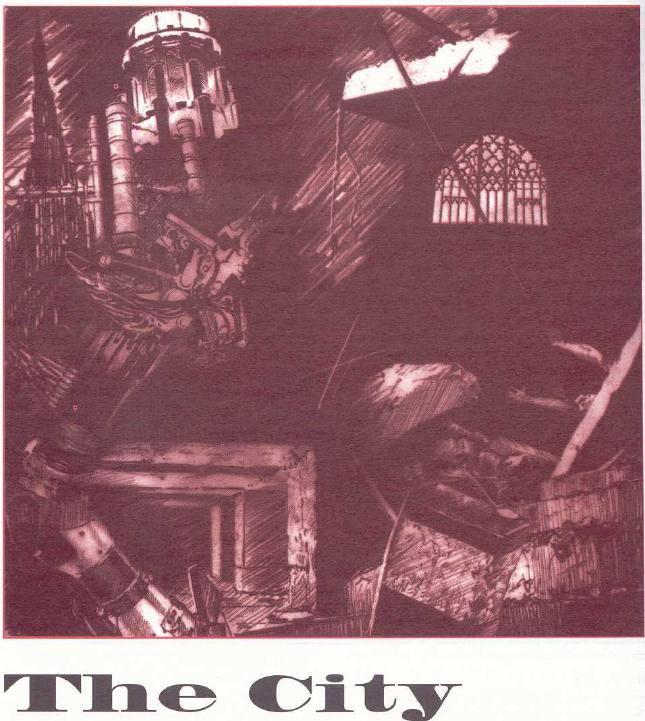
Beyond the general introductory stuff, we're first dumped into The City, this is the part of the real world that's closest to our own. The character in the introductory fiction experiences this as, while fleeing a gang, he leaps a fence in an alley and ends up in Metropolis.
Essentially, something about cities is just close enough to Metropolis in concept and spirit that when they get deep, dark and decrepit enough, at their hearts, gateways form. Which is why the Archons and Lictors have spent a lot of our history spurring barbarian hordes to wreck our cultural centers and generally keep us from urbanizing to any great degree.
Before you even break into Metropolis itself, though, cities house a lot of creepy shit both above and below ground. Most of the Archons and Death Angels also have incarnates(I should elaborate on these, actually) that own property which contains portals to their citadels in Metropolis or Inferno, respectively.
The Incarnates are another "why are these in the book at all?"-aspects, being powerful creatures projecting forms of themselves into other worlds. Essentially they're slightly toned down versions of the Beast, Seducer and Antichrist. Supposedly if we kill enough of an Archon or Death Angel's incarnates, we can injure or eventually actually kill the creature itself. But considering a combination of almost-irresistable mind control, five Fatal wounds and 50+ skill in all forms of combat... that's highly unlikely to happen.
But back to the City! Lots of old infrastructure, like disused subway stations and decrepit basements, lead into places with names like The Underground Metropolis and the Chamber of the Cube. They're also patrolled by supernatural hobos, literally, things called "Borderliners" that live half in our world, half in Metropolis and have completely and irreversibly lost their fucking minds as a result. They're cannibal hobos and are pretty decent basic enemies to throw at players who're close to crossing over to Metropolis, or just to have skulking in the shadows for atmosphere.
They're joined by Nachtkäfer, which are giant roaches. They're not particularly dangerous, especially as they run from light, including torches and flashlights. Not particularly interesting creatures, but they add a bit of ecology to the border areas and Metropolis itself. Make it sound like a place that has its own weird nature, rather than just being full of monsters.
We're also introduced to Geburah's private pad in Paris, where he basically has his Lictors hunt down extreme criminals and bring them back for him to judge Guilty and execute. Excepting the punishments for "abortion and witchcraft," it almost sounds like the sort of operation it'd be possible to sympathize with in as rotten a world as Kult's.
The Labyrinth
The Labyrinth is a subsection of the City which connects to the underground parts of Metropolis, but which has its own interesting things. The upper levels are populated by Borderliners and normal hobos, but the ones that manage to cling to some level of sanity usually become Children of the Underground. They have their own cities, cults and cultures underground and are a lot closer to human.
They worship something called Achlys and She Who Waits Below. Achlys is something deep in the Labyrinth that represents a total cessation of existence, and SWWB is its guardian. People who spend a long time in the Labyrinth dream about her and eventually get obsessed with finding their way to Achlys and dissolving themselves, wishing to cease to exist. As she often appears in their dreams as "a shining eye" or "a swollen, female body" I can only assume these these people just get tired of having to look at this shit whenever they close their eyes and figure oblivion is a better option.
Those Children of the Underground who style themselves Guardians of the Labyrinth chill in the underground city of Ktonor where they sacrifice tens of thousands of prisoners to SWWB and Achlys, kidnapped hobos from the Labyrinth or just kidnapped general people from the surface. It seems like an unfun place to visit.
Razides, which we don't know what are yet, lay their eggs in the Labyrinth, which then hatch into Larvae. They're big, wimpy ghost worms, really. Except for the fact that the book says you're likely to get mobbed and murdered by about five dozen of them at once. It mentions places call The Hatching Chambers full of Razide eggs about to hatch into Larvae, and by the description they seem to exist only for PC's to wander into in the pitch blackness, only for all of the eggs to hatch at once and the PC's to be buried under a couple hundred Larvae at once. Fun! Also you can't run from them because they're
ghost
worms that can wriggle through all inorganic matter, like the rock walls of the labyrinth.
Psilocites are huge ten-meter human worms. No limbs, huge and bloated, and wearing weird, metal exoskeletons. They're supposedly "not mad," but will catch normal humans and turn them into similar monstrosities over a course of years by "trapping them inside a half-dead body which is then mutilated." They're huge and tough but can't fight for shit and rarely ever travel in groups, so they mostly just exist if the GM wants to gross out his players and force them to make shock rolls. The book also suggests they're one of Malkuth's experiments.
Metropolis
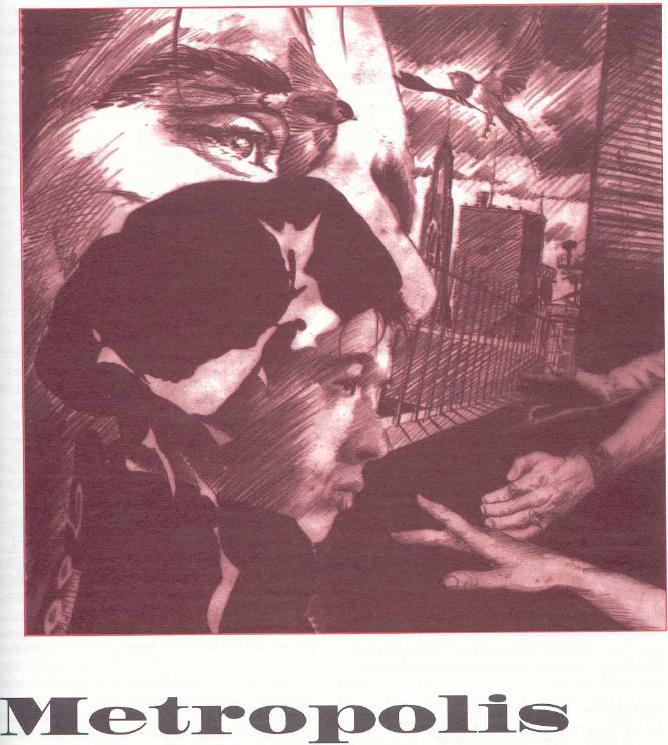
The intro fluff for Metropolis is about someone who's already there and obsessed with reaching the top of one of the Archons' fortresses. Decently well-written, and describes the decay of the place pretty vividly.
In case it hasn't come across yet, Metropolis is a huge fucking city. Huge, decrepit and decaying, and almost completely dead. Only in rare places are there any plants, but the place has shitloads of wildlife. Maybe it was always horrible and rotting, or maybe it just went right to hell after we lost our divinity. Who knows? Point is: These days it's a shithole. A dangerous one. It's made out of equal parts original material, and equal parts forgotten borderlands of known cities that have slipped over completely.
The scale of the place is also barely comprehensible, it's fucking huge, possibly infinite, with "squares as vast as oceans" and "the ten citadels of the Archons rise above the city like mountains." This is where they bust out some of the genuinely good writing, you really get a feel for the place and it makes you want to throw some players in there to have some goddamn adventures. It's a vast, rotting urban wilderness interspersed with tiny still-active enclaves of human activity. Hunter/scavenger groups, settled markets, small invasions of the normal world whose people don't realize Metropolis is just beyond their sight.
Oh, and then there are the Azghouls. Azghouls are dicks, but they have a reason for it. They used to be our servants/slaves back when they were divine, and now they spend most of their time in Metropolis, because it's a place from which they can easily jaunt over into our current world and harass/prank/murder us. If we know their names, though, they have to obey us, meaning that they're more than just wandering monsters, and could potentially be guides or allies. There could be a lot of depth and story in humans learning parts of their own history and perhaps feeling some remorse for having enslaved the Azghouls, balancing the temptation to bust out their names as weapons vs earning their respect.
Speaking of their names, they only have 1000 or so different ones, meaning that with a bit of guessing, luck and fast speaking, you could run through a good part of them when meeting a given park of Azghouls and have a good chance of controlling at least some of them. Physically they're big, ugly black-skinned blobs with bio-armor parasites that grant them super-senses and make them hard to hurt.
They're definitely created as enemies for the PC's to think their way around. Difficult to injure because of the armor-parasites, terrifyingly strong, but only about as smart and educated as normal humans and without the weapon-skills or supernatural abilities to instakill us as soon as they meet us.

In case you can't tell, I like the Azghouls.
After introducing us to the general feel of Metropolis and the major residents(scavenging humans and Azghouls), we're given some locations of interest, though the place is huge enough that a GM could cram several campaign worlds in there easily. Hell, you could set an entire Kult game in Metropolis, if you wanted.
There's the Maze, a potentially-infinite place with some vague rumours about it granting a return to divinity for anyone who manages to navigate it. The Hunting Grounds, which contain Ferocci and Wolvens, the former of which are just big and nasty, the latter of which used to be our pets. Both are functional enemies, but I wonder whose great idea it was to give the
wildlife
of a major part of the setting primary attacks that can insta-kill normal humans 35% of the time(or in the Ferocci's case, 60%). Wolvens are basically wolves that can stab us to death with elongated tongues, Ferocci are the big cat of your choice with the Predator's cloaking device and a Xenomorph's ability to climb any surface.
The Machine City
The Machine City is a subsection of Metropolis, several thousand square miles(quoting straight from the book, here) of enclosed building hall full of weird machinery that doesn't seem to produce anything or serve any greater purpose. Everything from steam engines to high-voltage wires, giant gears turning gears and nuclear reactors, can be found here. The parts that still function are maintained by the Techrones, which are basically robot humans with organic brains and organs. Inoffensive guys that just want to be left alone with their machines.
Their weird special power is instant understanding of any machine they see, including knowing how to fix it, what it can do and how to use it. Anyone who can't see a shitload of adventure seeds in that has a dead imagination.
The City of the Dead
The graveyard of Metropolis, I will just straight-up copy-paste the introductory description here, because I feel like it's really well-done. It reminds me a bit of Lovecraft.
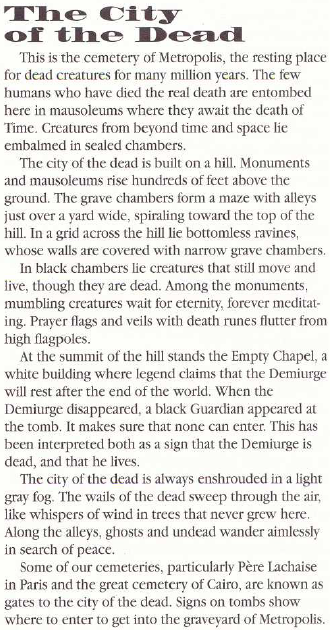
They never describe anything about the Empty Chapel where the Demiurge may or may not rest, nor anything about The Guardian. Despite the fact that he can speak all languages, we're not told how he deals with strangers(despite killing anyone who enters the Empty Chapel, or tries to). In fact, all they do is give him a stat block which, much like Astaroth's Incarnates, can be summarized as "fuck you." Unlike the Incarnates, which can actually be destroyed, however, the Guardian will just keep coming back even IF the players kill him.
This is unlikely considering his absurd stats(only one Fatal Wound, but the PC's are unlikely to know what he is, so they'll probably be up close where he can ruin them before they find out), which involve a sword that insta-kills anyone with a negative mental balance. For everyone else is "only" has the damage of a katana. Katanas have a basic 25% instakill chance against unarmoured enemies, the Guardian's bonuses increase that to 105%, he literally CANNOT roll under an effect of 80 on an attack roll and has multiple martial art abilities. Oh and he has 7 actions per round.
Potentially someone could be camped out on a mauseoleum some distance away and just keep plugging him full of lead whenever he gets up while the others run inside the Empty Chapel to check it out, but he has the skill Avoid Bullets and a minimum effect of 30 on a roll of that. So good luck hitting his overpowered ass. They might as well have replaced this entry with "See Lady of Pain, the."
Besides the Guardian, there are three "Dead Gods" in the Dead City. They send out undead butlers with invitations for tea(not literally, but essentially), and anyone who answers the invitation is fucked(literally and metaphorically). As soon as you walk inside you cannot ever escape, and after a bit of polite conversation with the Dead God, it, as the book states "satisfies its perverted sexuality," and then eats the victim whether they're still alive or not. "Since they are already dead they can take any number of Fatal Wounds," so good luck killing them. They don't really have any super-impressive combat powers(at last not compared to the Guardian on the same page), but a 50% chance of killing you with unarmed attacks and being unable to die makes up for that.
At least that's the Dead City done. Note that it literally only has a single thing that could be considered a "quest hook" without massive work from the GM, and it's guarded by an undefeatable thing.
The Living Gods
Apparently despite being LITERALLY divine ourselves when we lived there, Metropolis has temples, possibly up to 7,777 of them if the stories are to be believed. Oddly enough, the surviving Living Gods(which are now completely insane and basically hunt and kill people for sustenance) are actually wimpier than the animals earlier, a Ferocci could fuck you up a lot harder than Athrax, the example Living God.
The Underground
Basically this is the Labyrinth under human world cities, except nastier and with more monsters. Plus a few unique locations. The one we're introduced to is The Chamber of the Cube. It contains a 100m^3 cube of an unknown black material, and anyone who spends time in the chamber has their mental balance start dropping like a rock. There are a bunch of tubes, cables and wires that feed into the cube, but no one knows what it is or does. The only two rumours is that either it contains part of Achlys or an insane AI.
It's worshipped by the Achlytides. They are literally described as "half human, half caterpillar," and this is just what they are. Nasty, wobbly creatures that worship Achlys and the Cube as an extension of it. They can smell us from several blocks away, but are otherwise not dangerous. Though the book doesn't actually indicate if they're hostile or not. All we know is that they have a non-human biology and life cycle, and their own language, the latter of which suggests they're at least intelligent beings.
There are also Zeloths underground, which are basically skinless, hungry ghouls that lurk under the streets of Metropolis and communicate by rattling sewer gratings, coordinating positions before attacking. Despite this, they're really just sophisticated animals with no language or culture. I find it interesting that we get more information on the behavior and mental capabilities of what's basically just a random encounter creature than we do on the Achlytides and Techrones, which are ones the PC's might actually want to engage with on a social/intellectual level, rather than shoot.
The Citadels
The Citadels are the 10 towers from which the Archons work, or at least six of them are, with four of the ten being dead or exiled. There used to be an 11th for the Demiurge, but it's now replaced by the Abyss.
The bottoms of the Citadels are full of whatever squatters decide to hang out there, you're not likely to encounter anything even vaguely interesting until you manage to scramble up at least seven miles of ruined architecture and crumbling stairs. The higher up you go, the more well-maintained and modern things are, with newer kinds of architecture and still-functioning machinery. Of course, when you get there, you also start bumping into Lictors and Acrotides, both servants of the Archons.
Near the top, the Citadels split into smaller spires which are actually the Archons' bodies, and pretty much alive. Constantly changing and twisting and getting Player Characters irretrievably lost. Instead of describing anything about these parts, we're just told they're made of unearthly materials and populated by creatures "never seen anywhere else," in addition to Lictors, Acrotides and humans.
Oh and of course, Lictors and Acrotides kill intruders on sight unless they can talk their way out of it. Lictors are tough but beatable opponents if this should happen, Acrotides on the other hand swing around enchanted severed arms that cause permanent stat loss on contact, can work most magical rituals and have combat stats around the mortal human max. Now, you're thinking, obviously that means you need to talk your way out of it! Maybe you can do that with Lictors, who're somewhat mortal, but Acrotides are described as being "in constant telepathic contact" with their Archon and as "incomprehensible" otherwise. Meaning that you can't communicate with them and even if you could, their Archon's godlike intellect would instantly see through any of your ruses.
The Abyss
The Abyss is what remains of the Demiurge's citadel. A vast, bottomless pit from which only Astaroth has ever returned alive, despite the hundreds or thousands of seekers who've headed in to try and figure out what the hell happened to the big D. There aren't even any indicated rumours about what can be found down there, we're just told that it's a big hole that spawns monsters, Erinyae(which are all over Metropolis, but extra-prevalent here) and Crustacz, which are unique to the Abyss and its environs.
Erinyae are "flesh-and-glass pteranodons" which are really only a danger because they show up in large packs, just another addition to the ecology of Metropolis, rather than a kill-you-on-sight monster or quest hook.
Crustacz are 11-legged, flightless flies that attack with a completely ridiculous initiative bonus that mortals will never beat and 25% odds of insta-killing you with their claws or bite. On top of that they also pack paralyzing poison that drains 2d10 constitution(temporarily, thankfully) and will render you helpless if you drop to 2/3rds of your total CON. If we assume the average character has 10 or a bit over in every stat, that's pretty good odds of being instantly paralyzed on contact with these critters, which then proceed to drag you off into the Abyss. "No one who has been dragged off by the Crustacz has ever been seen again." Roll up a new character.
So that's the City and Metropolis. A mixture of interesting ideas and quest hooks, largely good descriptive writing, and far too many insta-kill encounters or things that just aren't given enough detail to be much use.
And for the record, no, there's literally NO art of any of these things that are described. No places or creatures. The only things that have anything but the odd chapter-intro art is the weapons and the archetypes.
Next time: Beyond Death, Beyond Dreams and, maybe, if the post isn't too long by then,
Beyond Passions
.
Kult 3e 1
Original SA post
The Kult I've been going through is the first edition, and I decided that I wanted a look at the 2nd and 3rd to see what they fixed. Could not for the life of me find the 2nd, except for its cover, which looks terrible:
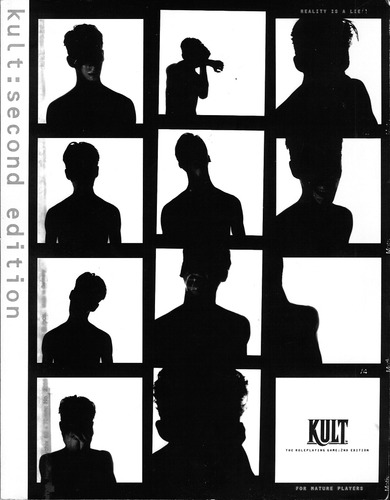
But I got my hands on the 3rd, and at the end of my review of the 1st I may go through 3rd and note things they improved, things they fucked up, things they changed(for better or worse) and you know what, it's already obvious that they fucked up two things badly just from a skim. The art is completely schizophrenic, wandering from bad photo manipulations that would shame the first editions of FATAL(where all the art was just the author and his friends in LARP gear passed through the "graphite" filter in some photo-editing software) to the old 1st edition stuff(in black and white, instead of red and black) and past something out of comics. Some of it's good, a lot of it's really not.
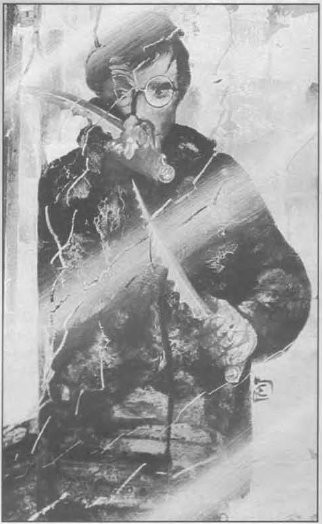
This one is arguable but... yeah, I don't know, I think it's just a new flavour of bad compared to the old archetype art.
And then there's the writing. 1st ed Kult's writing was really relatively under control and mostly about characters encountering horrifying, sanity-wrecking things and responding with terror, running, shooting or just getting killed.

This writing just makes ME want to run away in terror.
Actually, just one more. 1st ed Kult's Lore of Passion did note sex, yes, but largely it was about life and emotions in general. 3rd edition Kult knows no such limits:
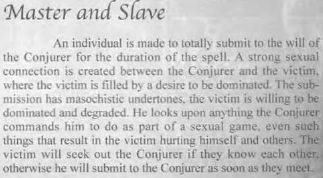
It's next on the chopping block.
Kult 3e 2
Original SA postKult 3rd Edition posted:
"The clip slid into the automatic rifle as though they were lovers."
Not that I want to spam up the thread, but God, the more I look at this 3rd edition of Kult, the more I want to murder everyone involved.
I did a quick look-over of everything aside from the heavy fluff-parts at the end.
Sanity and everything related to it: Aggressively copy-pasted from the first edition, same goes for the skills. Being friends with animals and really agile still means you can schizophrenic manic-depressive with a death wish and come up neutral on the sanity scale.
Magic, fluff and general writing: Shat on as though they hated the original authors and wanted to sully everything related to them.
Combat: Actually NOT stupid now. No vestigial rules like the body part shots(which had no effect except for making you less likely to hit), weapon damage makes a lot more sense(all weapons use a unified scale for determining scratch/LW/SW/FW hits, but have a different basic starting point on that scale, the Effect of your attack roll either moves you up or down on it) and there's no more ULTIMATE DEATH KARATE(which I guess could be a good or a bad thing depending on how you planned to run the original Kult...).
Art: So. Much. Worse. Except for when they inexplicably poach parts of the original art and paste them into sections unrelated to them. Speaking of said poaching, in the parts they simply kept, they also kept a lot of the old examples for rolls and play. Except in the original they were usually related to the chapter's intro fluff, which has all been replaced(usually with worse stuff, see the quote).
At least the 3rd edition provides its own reaction image.
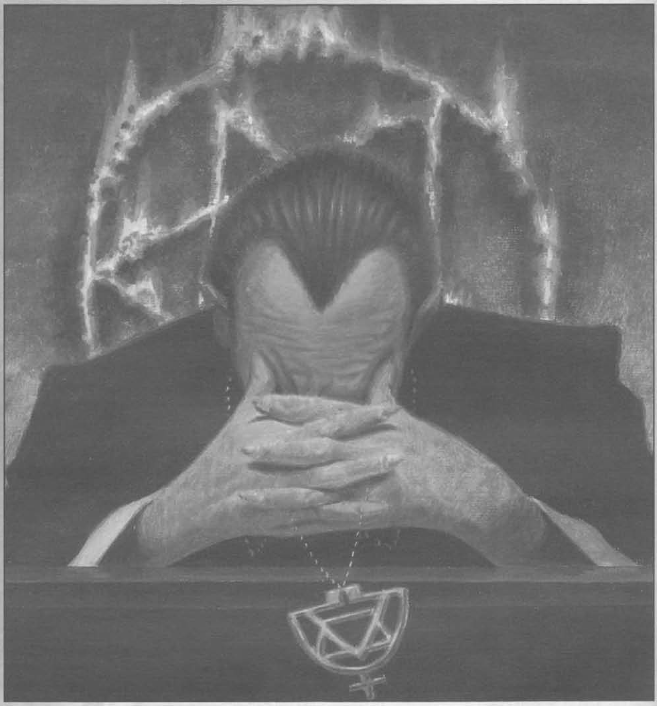
Setting/Story 3
Original SA post Kult!The Truth : Beyond Death, Beyond the Dream
Beyond Death
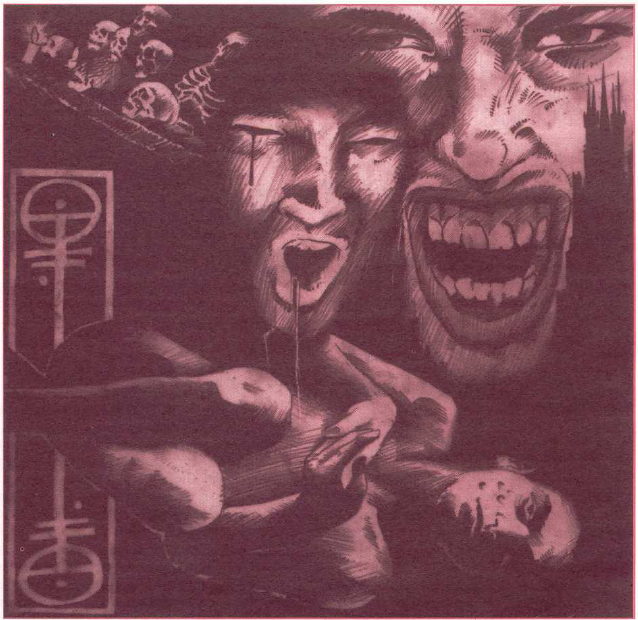
The cheering intro fluff for this chapter is someone dying and seeing hell looming ahead of him, Nepharites sharpening their knives and preparing untold torments. So he arrests his slip into Inferno and instead elects to hide out in his corpse, hoping it's all going to pass. Of course, it doesn't, and instead he's stuck there, mute and feeling every single second as maggots and decomposition deal with his body.
Delightful!
This chapter is, predictably, about what happens if someone dies in the Kult universe. Apparently, over the millennia of our imprisonment, only a handful of humans have been permanently extinguished. When we die, we just go right back on the ride of reincarnation.
When someone dies, their soul gets a quick scrub-and-rinse which erases the identity and memories of the past existence, however, so sadly we don't get much use out of it. Oh and like the guy in the intro fiction we can also be imprisoned: in hells, objects, semi-sentient animals, heavens, that sort of thing.
Apparently the mechanics of reincarnation tends to favour relatives, for some bizarre reason, but even when that doesn't work, we at least tend to end up with the same culture and language. Bizarrely this almost lends a bit of credence to racism, as even though our souls get scrubbed clean, our "original nature" remains. Any grouping that's got more than it's fair share of unsettlingly violent or otherwise nasty people, is likely to keep it as they just keep getting reincarnated there.
But hopefully that's not what the authors intended.
Also despite the COMPLETE ERASURE of our previous identities, all it takes is a bit of hypnosis or meditation to dig it out again. This is barely a paragraph after it was previously stated.
Just because things were getting a bit cheerful, we are then introduced to the "Corpophagus." They're fat, black leeches that burrow into human brains and, predictably, drive the victim crazy and then he dies. But if you're killed by a Corpophagus, your soul gets trapped in the body. Insanity and general misery ensue. These things are pricks.
There are zombies, which aren't very interesting, except for the fact that they're difficult as fuck to kill. You need to burn them to ashes or cut them to mince before they stop flailing around and being jackasses.
Oh and they can be created with Haitian Voodoo Drugs. Didn't see that one coming. Clever reference: Dr. H. West is also working on drugs that can re-animate the dead. Apparently in the Kult universe, Dr. Frankenstein is also not a literary character, but an actual person, and you can create stitched-together monstrosities yourself.
We've got Vampires, Nosferatu, which would be interesting except that they have the Commanding Voice ability from the Children of the Night chapter earlier. This means that unless they're completely retarded, they'll just yell at the PC's until they surrender or kill themselves. Considering their average Ego of 16, this is unlikely to happen. Oh yeah and they're also pretty much invincible to most weapons. Yet another creature that's literally useless without editing.
Oh and they know Passion Magic, so they're vampires that can knock you up from across the city with the blood they sucked out of you.
The Other Side
As mentioned earlier, where you end up basically works based on your own mind. If you hate yourself and are religious, you go to Hell, if you have a clear conscience and are religious, you go to Heaven. Or the nearest equivalent for your faith.
Atheists get stuck in "dreary shadowlands," so obviously the best choice is to be a complete narcissist who believes in God. This also suggests that suicide bombers in the Kult universe actually do get their 72 virgins. Guess this game has happy endings after all.
In game terms, your Mental Balance decides where you can go. Unless you've got a positive mental balance, the best you can hope for is the shadowlands, and if you've got a negative mental balance you can always settle for them. Considering how easy it is to go completely fucking downhill insanity after a few horrendous experiences, Kult's heavens probably never saw many visitors.
Hell's also stopped being a Suffering Mall and has sprung for more personal service. Apparently a lot of Inferno is now dusty and unoccupied, and the people who die with a feeling that they need to repent get in touch with Nepharites who conjure up a personalized purgatory for them to suffer in. No mention at all is made of what the Heavens are like and whether they have as good customer service.
Razides are Hell's version of Lictors, working directly under the Death Angels, and I always liked how they were described, as the creators sidestepped the obvious option of just making them fiery red dudes with bat wings:
quote:
"Razides are half living, half mechanical creatures with bodies of black iron, muscle tissue, glass and blood. They are almost 3 meters tall, humanoid, and always walk slightly forward-bent. An exo-skeleton of iron and glass hold the creature's organs in place. Reddish blood flows through tubes in the body. Their eyes are vividly alive, yellow with red pupils. They are the only visible life in a head of metal with jaws of steel."
And for some reason they have 3-foot organic tongues.
They're described as having trouble focusing on things that don't involve torturing humans and often "fall back" on that behavior if they lose their concentration or get stressed. I find that mildly hilarious, servants of Hell who may want or try to do something else now that their employer is busy planning his conquest of the Earth, but have trouble breaking loose from their old habits.
Hey, that's almost a marginal quest hook! Good job, Kult!
Due to not having Commanding Voice, they're also actually enemies that could be used as the "big boss" of an adventure or campaign. They can't mind control the PC's at will, they can't dodge bullets, they don't instantly return from the dead after dying... It actually feels like they were made to get involved in the game.
Inferno itself is basically red-and-black with lots of industrial machinery and the like around, and works a bit like an inverse of Metropolis. For instance, the Death Angels have citadels like the Archons, but these tunnel downwards instead of towering upwards. They are "filled with a complete darkness that allows no light to penetrate or be created," so basically they're not places that the PC's can ever enter.
Oh and if we have a less-than-0 mental balance when we enter, we instantly lose control of the PC as they come under the dominion of the ruling Death Angel. Sounds like an exciting adventure! Ah, but we could infiltrate with positive mental balance characters, perhaps they could learn how to navigate in the dark from the denizens of Ktonor! It could be ex-
quote:
"Persons with a positive mental balance may resist by making an Ego check with an Effect of 20+"
Oh, so we'd also need to have like 30 Ego or so to have even the slightest odds of managing it. Of course, the chances of having a positive Mental Balance after visiting Inferno is low, just looking at the sky forces Shock rolls, entering Death Angel citadels forces Shock rolls and being inside a Citadel makes your Mental Balance start just rattling downwards.
Nepharites
We're introduced to Nepharites and an example purgatory at the same time. Basically some dude who killed people in Vietnam and Cambodia now has to suffer for all eternity in a replica of his home town which is destroyed with napalm and shrapnel in the same way he killed people himself. A Nepharite hangs out and pretends to be his daughter, horribly murdered, apparently just for kicks.
This is kind of interesting, but the place essentially has no purpose. The character trapped there isn't anyone anyone would likely ever need to contact for information, he has no vital skills, and the place itself doesn't have anything worth exploiting. It isn't even a passageway to anywhere else, as we're assured that the Purgatories are basically only connected to the mortal world and nowhere else.
Nepharites are basically shapeshifters that prefer to show up as mutilated humans, probably to horrify sinners.

They are blatantly Cenobites.
Stats-wise they're somewhat more fragile than Razides, but probably far more impossible to actually fight, as they can "distort time and space" essentially at will, and effortlessly mind control anyone with less than -50 Mental Balance. So essentially the only people who're likely to see them are PC's who've died, or PC's who're going to die because they're fighting teleporting, time-jumping demons.
Beyond the Dream
You'd think dreams would be less interesting than Hell, but this place actually has more plot hooks and interesting-for-PC's ideas than any part of the game so far. In part due to a lack of superpowered creatures that are going to walk in and instakill us as soon as we get near them.
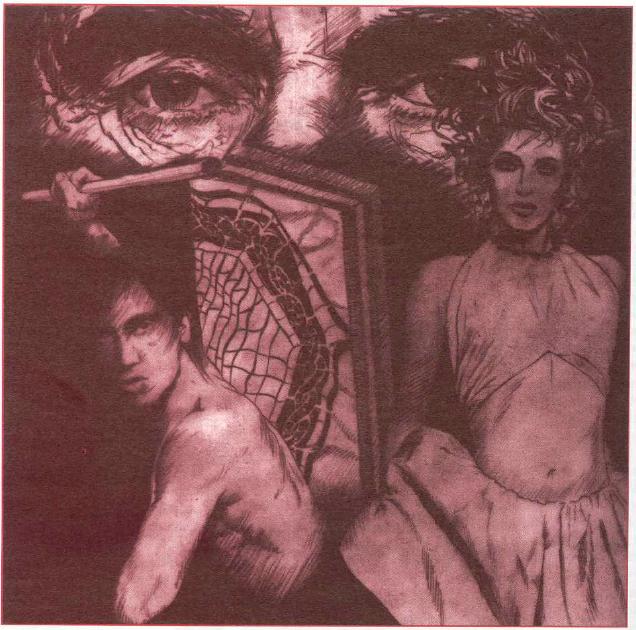
The intro fluff is interesting this time. Basically a guy goes to sleep and dreams up a bigger, stronger version of himself whom he acts as for the duration of it. Then somehow walks into the real world with this super-persona, while still being asleep in the real world, teams up with his friends, and goes off to kick some ass(namely the ass of a dude who's broken into his house and is probably about to murder him).

As we're going to see, Dream Mages seem to be the most active group of wizardy assholes around in Kult.
All we need to have the Art of Dreaming skill to affect our dreams and kick this shit into gear is to either just have a really awesome/interesting/weird dream or to have the Lore of Dreams. Basically it's the do-everything skill for the dreamworld, everything from lucid dreaming to affecting your dreamworld or to waking yourself up when you're about to be dream-killed.
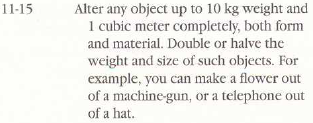
This is an example of the stuff we can do with the Art of Dreaming in our dreams(or others', where we're at a penalty to using it). I'm already starting to feel like this may be able to rival Rock Wizard Battle In Hell for Kult game concepts. We can also change ourselves in pretty radical ways with enough Art of Dreaming skill.
And then there's the fun stuff: We can drag others into our dreams or make gateways out of our dreams into the real world. At the point where we can do the latter, we're also powerful enough to grant our dreaming selves skills that our waking selves do not have. One party member could literally be a constant dreamer, snoring away on his couch at home, popping into dreams to grab machineguns, then popping back out again on high ledges to give his party covering fire. If he's about to die, he wakes himself up, watches a few cartoons, maybe has a beer, then goes back to sleep and returns to the action with an absurd rocket launcher and the knowledge of how to use it.
With enough skill, he could technically roll a fucking tank into reality. Though, note that the limit on what you can bring isn't power or complexity, but weight , I seem to recall someone writing up a post on what absurdity Mages could get up to when their only limitation was essentially volume. At the point where you can do this, you can create and bring objects of up to 26 kilos with you. I'm pretty sure there are a LOT of interesting objects that weigh less than that. Anyone know how much damage 25 kilos/50 pounds of plastic explosives can do? We're being generous and assuming that the last kilo is taken up by a big detonator or something.
You can also bring stuff from the real world into the world of dreams. You can be the master thief who never leaves his apartment and pays his rent with bills that he hauled out of a bank's vault while snoring away.
At 40+ Art of Dreaming you can also pull an IF YOU DIE IN THE DREAM YOU DIE FOR REAL on others, literally what happens to them in the dream happens to them in real life, but you can also use this benevolently. Say a party member is grievously wounded, he gets put under with anasthesia, you drag him into your dream where you've granted your dreaming self a vast knowledge of medicine and can conjure up basically any miracle drug or tool you want. After a couple of hours on the medical deck of the Starship Enterprise, your buddy is good to go.
You know what? Fuck martial artists. The real hilariously OP maniacs in Kult are fucking Dream Mages.
And we're not even done with this chapter yet.
The World of Dreams
The writers apparently realized how fucking cool this shit was and start kicking up the idea of entire sessions or campaigns occurring in dreams. I am fucking THERE, sir.
Dreams also don't give a fuck about time, so we're suggested that adventuring in dreams can let players find clues inside those dreams, leftovers from future thoughts and future dreams they're going to have after finding those clues in reality.
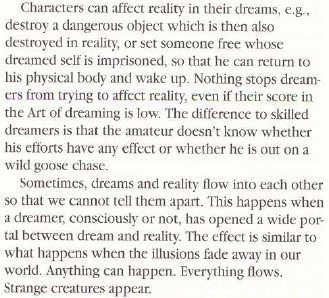
This suggests that the world of Kult is a lot more horrifying than it would normally seem. If dreamers who don't even know what they're doing can affect the real world, just by dreaming about it, imagine the weird shit that would be going on. Think about your last dream that involved a real place or a real person and imagine if your actions actually happened , or the actions of some other actor in the dream.
Dream Wanderers
Basically, we can drop the real world in favour of a world where we can make vanilla-flavoured rocket launchers and party in perfect cities that are under our complete and utter mental dominion as often as we want. We can create a dream-self and slowly transfer all our points of Ego to it, when our living selves are at zero ego, they become vegetables, but we don't care, because we can turn ourselves into Neil Patrick Harris now.
Hell, as far as I can tell, nothing stops a character from going Dream Wanderer and still opening portals to reality. Mostly humans are the only ones who get up to this(why? I mean, seriously, why? This sounds like the coolest thing EVER), and very rarely Azghouls will do it as well(hmmm, so they can drag us into dream realms they have perfect dominion over and they're really itching for a chance to boot humanity in the nads... yeah, okay, that's not good).
Our first example NPC of this chapter is a Dream Wanderer, a French guy named Armand. Basically a gangster who was permanently bedridden from injuries in the line of "duty," and, with nothing better to do, learned the Art of Dreaming, then transferred his mind to the dreamworld... but he never stopped being a criminal. Now he controls and organizes a lot of the French crime world from his dream citadel. As a villain to be faced by a team of experienced or rookie dreamers, and as someone that PC's might have a reason to go up against, this one is an A+.
Vortex
Vortex is the mental version of Achlys. Achlys dissolves physical things that come near it, makes them cease to exist. Vortex dissolves minds and identities. It's part of the dream realm, whenever you dream and have really weird, abstract dreams, it's because your dream is closer to the heart of Vortex than the more realistic ones. It's kind of an interesting concept, and we're given a few theories on why it exists, from it being the heart of humanity's collective subconscious to it just being a force of nature.
It helps add a bit of geography to the dream setting, but mostly exists to introduce some Dream Creatures that can go near it without their brains falling apart.
Ichthyrians are basically dream spiders who pull the DIE IN THE DREAM, DIE FOR REAL trick on people after hopping into their dreams, and then they eat them. They're not particularly dangerous, and any sort of experienced Dreamer is just going to turn himself into Conan the Barbarian with a flamethrower and make short work of them, but as an encounter for rookie dreamers, and perhaps as an introduction to the world of dreaming(someone you know turns up chewed to the bone in his bed! Gasp!), they're pretty good.
Psyphagi are assholes that try to lock up dreamers and steal their living bodies. They dissolve if they ever enter the real world physically, giving them an interesting weakness to be exploited by powerful dreamers(make a dream-reality portal and shove them or pull them through, watch them melt), and they apparently construct elaborate dream world fortresses where they chain up dreamers' minds while they enjoy having a physical existence in their bodies.
This makes them interesting enemies and, again, enemies that the PC's would have a reason to fight. The only issue is that their Art of Dreaming is at fucking 75. While their basic stats are unimpressive, that amount of AoD is enough to let them turn themselves into a minor deity at will, and considering that invaders trying to free captured dreamers will have a penalty in the Psyphagus' dream, that could need a bit of adjusting. But, lower that one thing a bit, and they're really, really interesting enemies.
Dream Princes
Because the Dream World needs a vague analogue to Archons and Death Angels we have the eight Dream Princes, essentially eight human dreamers who're of legendary power and exist entirely in their own, twisted little pocket dimensions in the dream world.
They're basically fighting to control the Vortex so that they can wrest control of the entire dreaming world from everyone. Considering what sort of power that would give them, it's probably a good thing for the rest of us that they're not getting along, and this adds a level of intrigue, politics and just plain interesting bullshit to the dream world that Metropolis and Inferno completely lack.
Hammad al-Sufi is the oldest one, who claims to have been at the dreaming shit since the days of Noah(yeah, the one with the ark) and parts of several Middle Eastern cities are essentially outgrowths of his realm.
Deride Aristides is a dreamer from the 24th century, her worlds are cyberpunk/cyberspace fantasies, and include gateways to future military and space installations. Imagine having to breach her cyberpunk worlds, beat down the local guardians and bust into a future space station, score a haul of laser weaponry and then drag it back to the real world, where you use it to gib Razides or something. She has cyborg monstrosities guarding the aspect of her realm she usually hangs out in, which just makes me think a bit of SHODAN.
Aaron Greenberg is an ORDER AND LOGIC guy, meaning that his dream realms are places of horrifying bureaucracy. Pointless rules, arcane ways of doing things and oppressive levels of guards and police. It's got some creepy shit going on with him copying people and populating entire dream worlds with nothing but physical-and-mental copies of the same person. He apparently really likes repetition.
Friedrich Köpfel is a 17th century Alchemist, and his worlds are basically dark fantasy realms full of living dead and monsters, full of curses and magical traps. Kind of like a creepy enchanted dungeon crawl.
Nikolai Makarov is 16th century Russian monk who wants to take over the Vortex to purge humanity's sins from their minds. All of his realms are vast cathedrals and monasteries, or burning hells for sinners he captures.
Samara Nyeme is an ageless African dream princess who basically dreams of Africa. Not as interesting as the others, really, it's either trackless wilderness or shitholes riven by war and famine.
Nicolette Pasteur was crazy even before she became a dreamer, and her paranoia has infected her worlds where literally everything is out to get you, even the plants and the furniture. Not a nice place to enter, and apparently portals between her world and ours can open unpredictably, meaning that they can be a nasty surprise for people if their kitchen suddenly tries to murder them because Pasteur's world flooded into it for a few minutes.
Caren Birchlime is the cheater of the eight, she basically got her powers by getting ridiculously high on experimental drugs and having trippy-ass dreams. Even in her dreams she's still getting high, permanently chained to a hospital bed where she gets juiced up more and more. She's also pretty scary and predatory compared to the others who mostly sound like they may capture or recruit random wanderers who enter their realms by accident, Caren on the other hand actively hunts for weak dreamers to torture.
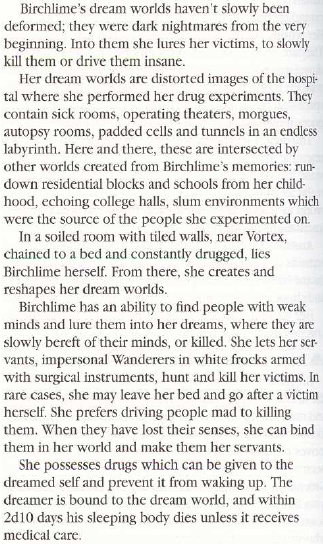
Enter Caren's twisted dreamworlds to rescue someone AND break into her hospital labs to find an antidote for the dream drug binding them there! While a couple of party members stay behind to safeguard the victim, others bust back into the real world and rush to the hospital, fighting or tricking their way past security to reach their friend and giving them the weird concoction they found in the dreamlands...
Most of the dreamers are pretty much impossible to beat in a straight fight in their own dreamworlds, but some, like Nikolai, could potentially be defeated if they could be lured into someone else's worlds, or the real world. In others' worlds, they'd have enough of a penalty that they could be challenged, in the real world they could still have horrifyingly boosted selves and weird equipment from the world of dreams, but at least they couldn't fuck with the reality around them to instantly destroy intruders. Still, most of what PC's would encounter in the dreams would be their servants and minions, most of them aren't even statted beyond their skill in Dreaming.
Next time! Beyond Madness, Beyond Passions!
Setting/Story 4
Original SA post Kult!The Truth
Beyond Madness
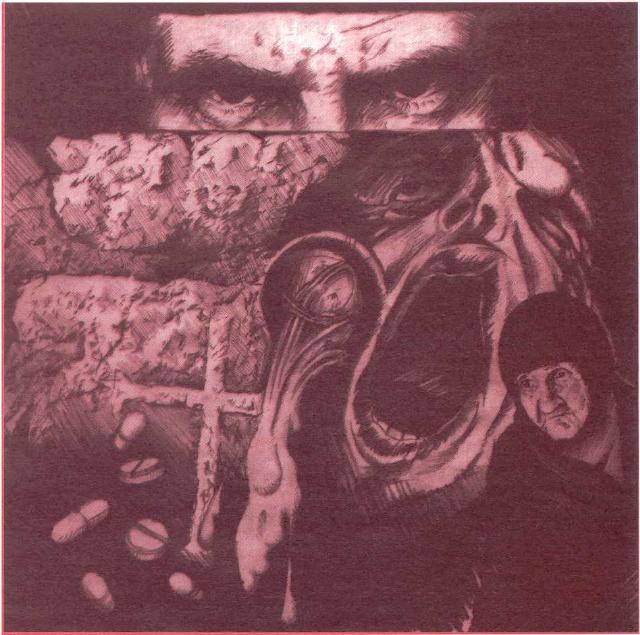
Granny staunchly ignores these modern graffiti artists and their bullshit.
So anyway, BEYOND MADNESS. If you haven't noticed, there's basically a Beyond for each magic Lore, excepting Reality. The intro fluff is about a mental patient who's fed pills until he goes insane and makes the walls sprout tentacles that kill the nurse feeding him the drugs. Also for some reason, despite the graphic descriptions of murder and death so far, this piece of fluff censors the word "fucking." Yes, the word "fucking" is surely more shocking than descriptions of the tentacles drinking the nurse's blood and tearing her apart into gory chunks.
First off we're told that madness often isn't actually, y'know, madness. Instead it's all about the human mind being in conflict with the Illusion and trying to make up shit to deal with it even as it sees part of reality. There's also proper, standard craziness, but luckily that gives you superpowers, too! It's also revealed that having a Mental Balance of +75 will get us marked as crazy, too, though it's unlikely to happen because people in the high positives rarely exhibit their craziness by burning things down or killing people.
The clusterfuck of rolls that is sanity checks is further compounded here with a throw-off line telling us we need to make YET ANOTHER fucking Ego check to avoid hallucinating when we see something shocking.
The "standard" hallucination is one that distorts time and space, the examples given by the game are taking a week to walk to the bathroom or accidentally "walking across the continent" when popping out to buy smokes. Furthermore, this is completely uncontrollable and only there for the GM to fuck with his players.
Back in the sanity section I also mentioned "Projecting," where really terrified people with low Mental Balance could accidentally make their fears, or something related, actually assume physical form. Apparently those who are seriously mentally ill can do this at will, whether horrified or not, making their madnesses real. It's written in a confusing manner that first says we don't need to be terrified like others, but then afterwards says that if we're terrified we can risk projecting it. Sadly this doesn't seem to have any completely gamebreaking applications like dreaming does.
Alucinades are two-dimensional spawn of hallucinations. They don't have much of a purpose besides hanging around and hunting the crazy person who created them, and the book says nothing about what the requirements for their creation are, so presumably anyone who gets shocked badly enough to see some weird shit risks being hunted by toothy shadows until they kill them. They're not very dangerous, though their high Strength and Agility means that if they pick up a weapon(and considering that they have skills for "whips and chains" and "impact"(blunt) weapons, it's implied that they can do this.), they could be pretty dangerous if the dice favour them.
Working at Mental Hospitals will apparently rot your sanity away rapidly if you've got even the slightest negative balance and we're told that "there are plenty of insane psychiatrists and analysts," between this and the fact that Mental Hospitals are apparently easy portals to both Inferno and Achlys, they're already starting to sound like really fucking dangerous places. These places CAN apparently fix people, but it's randomly determined if they can or not, we're told to just roll for it and the odds are 50% destructive, 40% can't do shit for anyone and 10% can actually help people. Seems like the staff go crazy even in the good hospitals, though.
Amentoraz is a creature that stalks institutions for crazy people. It's essentially an Alucinade that's a reverse-therapist. During the day it's just a shadow that lurks around, during the night it takes human form, captures patients and talks them into going crazier and more depressed. This apparently makes their stats leak out of their ears and it eats their Ego until they become vegetables. There is also no saving throw. At all. It's completely immortal and just turns into a shadow and walks away if someone whacks its human form "intensely," suggesting that mostly it just sits there smiling at you and hitting you back until it gets annoyed. Yes, it can hit you back, it has superhuman strength and besides that telekinesis that can move up to 100 kilos at 10 meters per second, hardly as fast as a bullet, but enough to drop or knock over heavy things on people and sabotage places. Presumably it could be exorcised by a Crazymancer, being a creature of madness, but outside of that it just exists to kill or annoy PC's.
Therapy and Analysis is remarkably simple. Make an Ego check to bring yourself to attend, and if you're so crazy you've "lost control of your emotions"(presumably the level at which your disadvantages PERMANENTLY crack open), you need to make this check every week. No rules for whether this has to be done even if you're court-mandated to attend, locked up in an institution or your friends stage an intervention of some sort because you've started killing dogs in your spare time. This gets you the grand, total boost of fixing your Mental Balance upwards by 1 point for every month of therapy. However, considering that you no longer seem crazy above -50, I assume that at -49 the therapist just sends you his bill and tells you to check self-help books. They also can't help cure your actual Disadvantages, but thankfully we can just buy those away with XP.
The Realm of Madmen is pretty much any place that enough crazy people hang around to make reality twist into a strange pretzel shape from the combined effect of all their insanity. Apparently they universally have democratically elected leaders called "Princes of Fools" and establish systems of laws. The specific example Realm we're given is one under Frankfurt, where the crazies are apparently organized enough to engage in civic projects to excavate themselves a larger home, on top of all their legislating.
If you walk the wrong way, though, you can accidentally break reality, at which point the crazies will come running and do wacky crazy-person rituals to make sure they don't get swarmed by packs of Razides or whatever the hell is going to stream through if reality doesn't get duct-taped back together quickly.
Everyone who lives here has a Mental Balance between -50 and -150, except for their kids, who go insane as part of growing up. Either the Halls under Frankfurt are just that horrifying or going insane is a genetic thing.
Despite having told us, about a page earlier, that "the societies of the mad are about as moral as the societies of the sane," we're now told that the Frankfurt Crazies have regular human sacrifices to Nepharites and other demons to guarantee their own safety. I think you need a lower Mental Balance than mine to understand a system wherein this counts as moral/ethical behavior. Oh and their ruler is a sadistic cannibal who cannibal who demands that others embarrass themselves for his entertainment.
Furies and Cairath are the monster entries that cap off this chapter. Furies are just REALLY crazy people with enough deformities that they've turned into dangerous, tentacled animals, and Cairath are huge metal-and-flesh constructs that shuffle around underground, catch people and then glue their own dead flesh to themselves. Note that these people do not die immediately even despite being half-submerged in the body of a Cairath. Grisly. As enemies go, Cairath and Furies have no instant-victory or can't-ever-kill-me powers beyond the usual absurdity of Kult's combat system where even a half-hearted kick will kill someone if the dice will it.
Beyond Passions
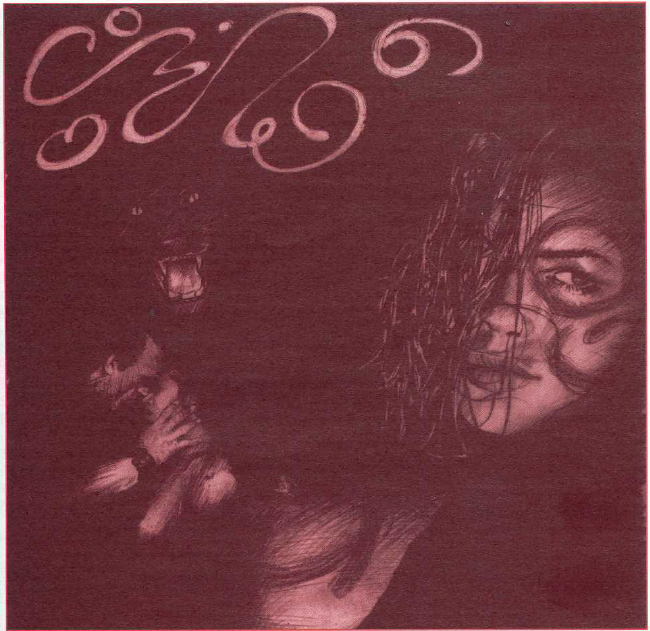
Time to see just how bad this is going to get.
Judging by the intro fluff? Pretty bad. Some woman paints herself up and makes a ritual that summons a panther that fucks her and turns into a human. What? Just... what?

Pasted here in its entirety just because I want to prove I'm not making it up.
So with the bar set that high, let's poke into the actual writing and... goddammit I think I'm going to need to copy-paste some more, because I really just can't do this justice by writing ABOUT it.
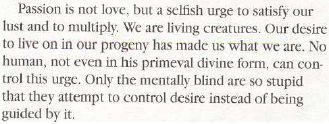
So fucking is power. Good to know. Apparently Darwin and Freud realized that fucking things and producing more humans is the core aspect that defines humanity, and it's only because our minds are trapped in these imperfect forms and this imperfect Illusion that we can ever deny it.

And fuck necromancers, fuck crazymancers, fuck dreamwizards. The only proper way into becoming divine again is to stick our dicks in things. The book takes a quick break from preaching about divine boners to tell us that any seduction and attraction should be ROLEPLAYED, fuck the dice, this is where it all matters. Jim doesn't get to wriggle out of roleplaying his lusty sorceress boning the panther, this is about his character's potential divinity, goddammit.
"A person with a mental balance around zero will avoid sexual passion at all costs." So if we're normal, well-balanced people, we're also impotent and/or afraid of sex. "Desire first makes itself known as attraction to another person, or more rarely to another creature." Thank you for opening the door to passion magic involving dogfucking, Kult, thank you so much. Once we're attracted to something it WILL mount into an all-consuming obsession that it requires Ego throws to resist, and the penalties just keep mounting until you go crazy and try to fuck it. There is also no such thing as extreme or minor attractions, it all goes to a level of "will follow the object of admiration through death."
This makes us so obsessed that all we care about is fucking this person, in fact we cease to care about the Illusion, too, which makes it go away. What about other obsessions? The dude who spends five hours a day painting his Gundams? The guy who plays World of Warcraft every waking moment? Do the Illusions crumble for them, too? Considering the chapter on Madness suggesting that just being sufficiently crazy makes reality cough up a lung... they may be closer to divinity than we are.
Oh, yes, and because this chapter wasn't already stalkeriffic enough, Passion-spawned reality-twisting is always related to the object of affection. Like twisting space to warp closer to him/her, it lets you warp into goddamn Inferno if they killed themselves to get away from you if their soul is there, and you can apparently trap their soul in their body so they can never move on, creating some sort of horrifying necromantic RealDoll. This is also something that cannot be controlled by the stalker in question, and apparently requires no magical proficiency or skill at all.

We get a short gameplay example after this paragraph where Gilbert, unable to control a raging boner for Natasha, pokes a hole in reality with it(metaphorically, thank God) and chases her into some little Oriental-seeming pocket dimension. He sees her, and she's got metal skin. He goes after her anyway, because he CANNOT CONTROL HIS PASSIONS.
Perversions are apparently really handy ways of prodding holes in the Illusion so you can become enlightened. It seems that all of our normal sexuality is created/enforced by the Demiurge to make us forget how awesome all this SEX AND PASSION is, and whenever we do something ridiculously perverted, it can shock us and drop our Mental Balance, which puts us on the train to Enlightenment Town. And also Crazy Town.
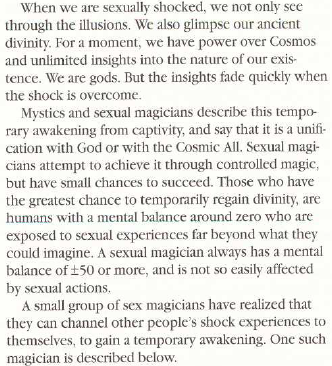
I like how the Lore of Passion chapter made it seem like this stuff was about life and emotion in general, and now this chapter is reminding us that the first time we fuck a car or get whipped by someone in a gimp suit, we temporarily become Gods again. That's just so great. I fucking hate you, Kult. Why did I ever think you were awesome?
The Universal Church of Love & Fulfillment are the sex mages mentioned in that chunk of text. It's run by Papa Beauchamps, a wizard who realized that sex had way more power than magic. Unfortunately he'd already had "vast sexual experience" and there was little left that could shock him. So he made magic spells that would let him channel other people's shock to himself. So, just to make sure there's no confusion about this: He makes a sex-cult where he uses magic from people shocked at their own boner experiences to empower himself. "Teenagers are lured into the church by the prospects of free sex, but soon find themselves in a degrading bondage under the leaders and older members of the group." I think I liked the crazy Fishmalks living under Frankfurt better. There's also a brief bit on exactly what happens on Beauchamp's private island of San André, mostly it confirms that he fucks children.
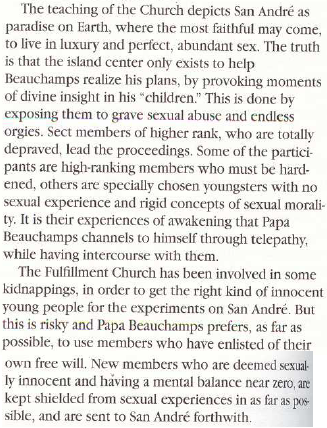
Thankfully his stats reveal that just about any players can put this sick fucker down in short order. The next short bit is called "Coq Rouge" basically a porn mafia that buys members of Beauchamp's cult as slaves for their productions.
Libiths are suggested as being humanity's old prostitutes from our divine days, and like the Azghouls they're back for revenge(either that or they're just real dicks). They're shapeshifters who show up as really sexy people, get us to fall for them, and then slowly become more and more inhuman as the relationship progresses, but apparently our BONDS OF PASSION are too strong for us to dump them by the time they've got seven spider legs and are giving us blowjobs with acid-coated mandibles. We have to beat them in an Ego contest in order to avoid this.
Dartheas are fuck ghosts that possess us and make us bone just about everything we see. That's literally their only purpose, oh and they don't know about our body's needs for rests so they will literally make us fuck ourselves to death. Again we need Ego checks to avoid this horrible fate.
The last creature, and also the ones that end the chapter, are Gynachides , who are actually somewhat interesting. Basically they're near-human creatures capable of becoming pregnant, but not of giving birth on their own, and so they visit our Illusion to implant their children in humans. Gynachides mostly hang out in Metropolis the rest of the time, being dangerous-but-intelligent predators, but it can be assumed that they'll watch over the midwives of their children and they tend to actually leave gifts once their kids are born and grown(which happens fast, like a year or so). Oh and apparently the children will sometimes pop back to the Illusion and abduct their foster parents back to Metropolis, though it says nothing about what happens to them, whether they're eaten or become part of the family or what. But it's actually something that could be used for a quest hook without too much effort, and Gynachides are dangerous-but-defeatable in a fight.
Next time, Beyond Time & Space and I finish off this damn book.
Conclusion
Original SA post
Last Kult update, this one isn't going to be very interesting because, honestly, the end of the book isn't very interesting. We've already gone over all the really broken parts, most of the really horrendous enemies and past all of the dumbest fluff. Now it's just cleanup.
Kult!
The Truth
Beyond Time & Space
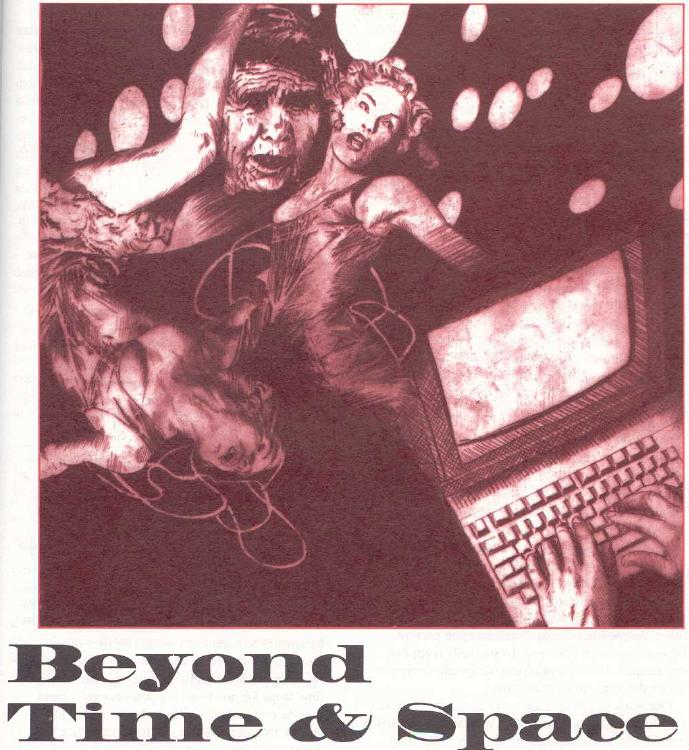
After the usual intro art comes intro fiction. In this case someone writes a MYSTIC EQUATION on their PC and, rather than being turned into Freakazoid, they get surrounded by bad CGI effects and teleported into the future, where their future self, a withered old lady, leads them off to tell them secrets.
Time
Time and Space are, apparently, just something that exists because we tell ourselves it does. All we need to do is look at them differently and we can do all sorts of wacky shit. Predictably, one we go crazy, our perceptions go OFF THE RAILS and the crazier we are, the less predictably time acts around us. Somewhere around -150/+150 Mental Balance we can jump 3 years back or forth in the time stream with no effort or wizardry involved.
Considering that it says "at will," however, I have to wonder why they even bother adding a maximum limit to how far you can jump. Can't you just jump that far back/forth and then make another jump "at will"? The book never says.
PARADOXES don't break all of time, but can trap specific people in their own little fucked up loops of time until they go crazy enough that they perceive time differently, or until alien entities with weird ideas about time pluck them out of it.
To avoid PC's completely wrecking the setting with a bit of easy Time Travel from using the basic Lore of Time & Space spells, there are Aetats, which are like Time Cop Dogs. Angry animals that leap out of "time distortions" if anyone repeatedly and succesfully messes around with altered perceptions of time, and have a 50% chance of killing you outright if they hit you. It says that people who do any time travel bullshit "risk being detected," but doesn't actually give any guidelines for whether they pounce on the slightest deviations or only attack grievous malefactors. So basically they exist as a way for the GM to go: "Stop fucking around in time, assholes, or I'll throw TWO of these at you next time."
The description also seems to really invoke the Hounds of Tindalos.
Space
The rules for being a crazy space-hobo are much the same as those for being a crazy time-hobo, except at the same level of madness we only get to leap two kilometers at will. Still pretty handy, but not quite as broken as being able to go back to yesterday and plant a bomb exactly where the guys trying to kill you are going to be. Or hopping back an indefinite number of years and murdering them as children or something. But probably a bit less risky in the whole "getting trapped in a paradox"-realm.
Aspecti are the space versions of Aetats, except quite a lot worse. Basically they're space-hitchhikers who see space in such a radically different way than us that normally we can't even perceive them. Then sometimes they get stranded in our region of space and need to hook up their brains to one of ours to jump-start their space adventures again. It takes 1d10 minutes for them to paralyze a sleeping or helpless character in this way, and then 1d10 hours for them to jump away... with the helpless character in tow, forever dragging them out of our realms of perception.
Hooray for more ways to fuck your PC's sideways!
Achlys
Remember Achlys? From several chapters back? They remind us that it exists and then tell us that anyone who jumps too much in time and space risks accidentally wandering into it and dissolving themselves. No guidelines or saves from this, it's just something that happens if the GM thinks you exploit it too much. Also you don't just cease to EXIST, you cease to have EVER EXISTED.
The Cults
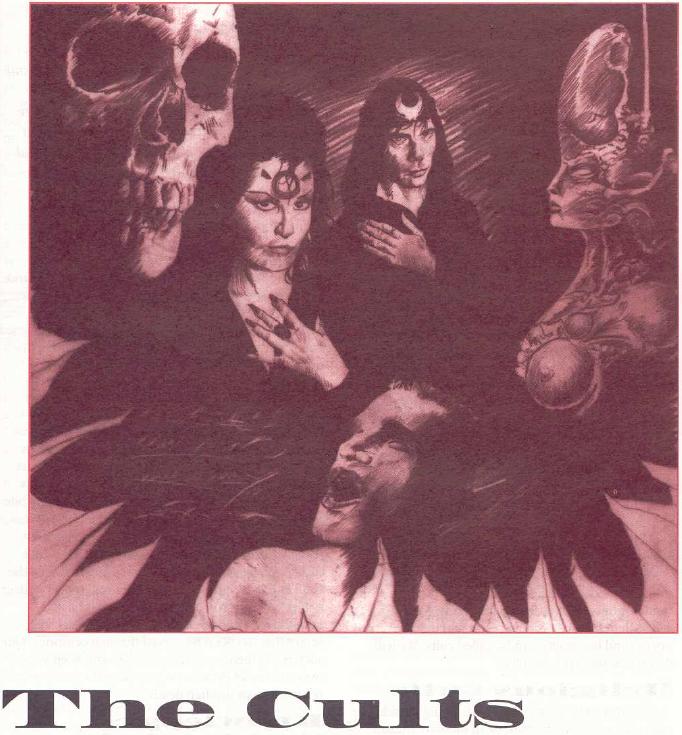
Intro fluff: Some dude watches from a hiding place as a bunch of cultists, predictably wearing leather and plastic, prance around his friend's office, chanting about Astaroth. Then they bring in his friend and sacrifice him with a chainsaw, spraying blood everywhere. Reasonably metal.
Then it starts listing the types of cults. Religious Cults worship otherworldly creatures, Guardian Cults protect supernatural objects or locations, Knowledge-Seeking Cults aren't really cults but just groups of scientists, Power Groups are an organization that includes the Freemasons, Neo-Nazis and left-wing radicals. The Illuminati are real and apparently some of the few people who suspect the whole "Illusion" thing is happening and try to break through it, Perversion Cults are specifically mentioned as "stealing children," though thankfully there's no more elaboration on that aspect. Surveillance Cults are lictor-run groups that hunt down other cults and apparently put lots of hippies in jail.
And then, suddenly, the game remembers it's a game and starts suggesting things we can do with the setting. It's something as mild as "YOU CAN HAVE THEM FIGHT CULTS," but it's kind of refreshing to see that it's trying. Then we get a template for making cults with and some example cults! This should be exciting!
Legions of the Damned
Basically these aren't really a cult as much as they're Astaroth's legions of dead sinners that he dragged into the world to help him conquer it. The actual cult part would be the swarms of mooks that worship these deformed goons. He's got about a million Legionnaires and they're roughly immortal. The only way to temporarily defeat one is to smash him apart, grind him up, burn him to ask and then scatter the ashes to the winds, which still only gets you a few years of peace from a now, presumably, very pissed-off Legionnaire.
Combat-wise they're essentially human, however, but the whole "inability to die easily" means that the odds favour them murdering a PC before a PC murders them. They also have roughly -150 Mental Balance, since they're still fundamentally human, that would presumably mean they can teleport and time travel at will, especially as their "powers" section reads: "Any abilities applicable to people with low mental balance." So you've got immortal zombies that can teleport through time and space to fuck you up. Why does Astaroth need more than a million of these assholes to conquer the world again?
Satanists
This is really rather bland, but a couple of interesting things pop up here. Obviously these goons are Astaroth's human dorks, laying the ground work for his conquest. Violent maniacs or sinister plotters. But what's interesting is who opposes them. Here we learn that the Catholic Church, run by the Archons' Lictors, actually fights Satanists. It's the first time we've really had it mentioned that the Archons are in any way opposed to Astaroth's whole "reinforce the Illusion by murdering the shit out of the world"-plan.
But apparently the Mafia fights the basic "Heller" gangs of violent sociopaths, and the Vatican is at war with the more sophisticated Satanist lodges that try to do clever behind-the-scenes shit mixed with blood rituals. This could actually lead to some interesting things as not-really-invested-in-the-mysteries PC's would obviously want to stop Satanists from sacrificing their neighbours, and end up teaming up with Archon-controlled organizations for this purpose. Later on, assuming they survive long enough to start knowing about the truth of the world, they could learn how the Archons are in essence humanity's enemies. But the book doesn't mention anything about such alliances so it can be presumed that this interesting idea is just a fluke.
Guardians of the Labyrinth
So basically these guys are hobos that sacrifice other hobos to appease She Who Waits Below and have some poorly-defined magic that lets them control and protect-against the monsters that hang out underground.
They're kind of pointless since they specifically do not mess around with the world above if they can help it and don't really have any friendships/hostilities with PC's adventuring in the Labyrinth or near Ktonor. They could be used as an extended network of contacts, but that's about it.
The Awakening
So this is basically what the entire setting is about. The last chapter that covers any sort of fluff. This is what should rock our goddamn world and convince us to dive headfirst into an awesome game of Kult. Oh except that the book kicks it off by telling us that we're never going to use this in our games because any PC's above or below +100/-100 Mental Balance is unplayable. But that's okay, I'm sure we can make some cool NPC's with this stuff.
Otherwise the introduction doesn't tell us much we don't already know. High Mental Balance involves SUPPRESSING YOUR URGES while Low Mental Balance involves SURRENDERING TO THE ID. Considering that a few chapters back we were told that the only true way to divinity was fucking a lot, I suppose Low Mental Balance is the "right" way to go.
This is also where the game elaborates on the term called your "Shadow," get crazy enough and your mind spawns a literal inverse of yourself, in both physical form and mental balance, which "tries to stop you from advancing farther." Unfortunately that's about as far as it goes. It doesn't say if the Shadow will try to kill you in your sleep, disrupt your meditation, set your car on fire or what.
It reprises the scales of what different levels of crazy will do, but adds a few new things for the really high levels, such as the fact that very low Mental Balance characters will find their disadvantages to be "infectious," affecting people around them and lowering their Mental Balance as well. Having super-high Mental Balance seems a bit odd, though. On the one hand, you're all about ICE COLD ANALYSIS, on the other hand you also find social relations and the like to be of supreme importance, the two seem a bit at odds. But the upshot is really that you lose your emotions, your
advantages
become infectious and eventually you no longer have any physical needs or desires.
Just before the Awakening we can be trapped in Chaos or Nirvana, respectively and... the game tells us fuck all about these. There's a single paragraph for both and all it says is that they're traps that we need others to push us out of. Are these physical locations? Mental pitfalls? What? Who knows?!
Once we Awaken, however, we basically win the game, being superhuman entities that respawn with all skills and abilities if we're ever killed, though it suggests that there's another level of adventure beyond here, as we can now perceive worlds which "humanity never inhabited" and learn the Lore of Reality. Did they want us to play this far or not? Make up your fucking minds.
Adventures & Campaigns
This is a little vestigial section that ostensibly has "adventure seeds," but they're as generic as "Stop A Bad Thing From Happening." it doesn't even tie any of these into the fluff we've read so far, any ideas on how to use it, beyond suggesting "stop a cult" at one point. We're reminded that "sex" can be one of the events in our game, along with LOST or COMMANDO RAID. That the PC's need a motivation to go on the adventure AND to stick with each other.
Essentially some RPG Storytelling 101 which could be used for just about any other game, just replace "car chase" with "cart chase" if you're playing in a fantasy setting.
The End
And that's that. That's fucking Kult. A mess of vestigial and aborted ideas intended to cover more space than Planescape, and doing it worse. Attempts at involving mature ideas that just turn immature. Completely broken abilities for characters. Literally undefeatable enemies.
I'm glad I did this, because I used to think Kult was pretty awesome. This took care of my rose-tinted glasses. Christ what a mess.
Considering how much the 3rd edition cribs from basic Kult, and what it doesn't directly steal, it usually fucks up (combat excepted), I would be interested in seeing what the 2nd edition does. Either it's a total divergence and 3rd edition is getting "back on track," or it's even more of a copy/paste job. If anyone here's read the thing or got it on hand, I'd be interested in knowing.